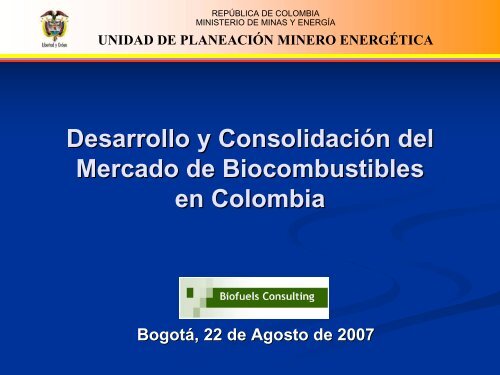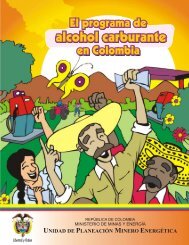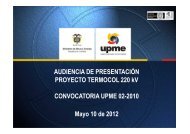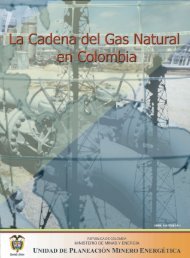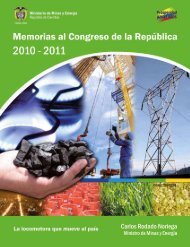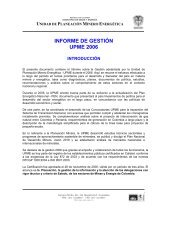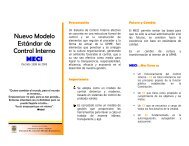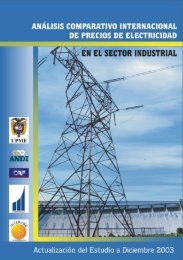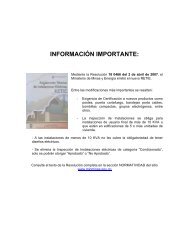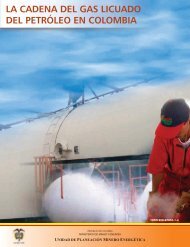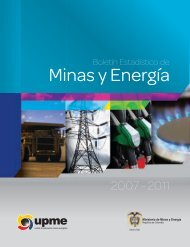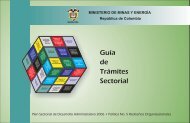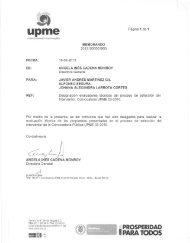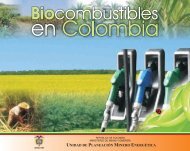Biodiesel - Unidad de Planeación Minero Energética, UPME
Biodiesel - Unidad de Planeación Minero Energética, UPME
Biodiesel - Unidad de Planeación Minero Energética, UPME
Create successful ePaper yourself
Turn your PDF publications into a flip-book with our unique Google optimized e-Paper software.
REPÚBLICA DE COLOMBIA<br />
MINISTERIO DE MINAS Y ENERGÍA<br />
UNIDAD DE PLANEACIÓN MINERO ENERGÉTICA<br />
Desarrollo y Consolidación n <strong>de</strong>l<br />
Mercado <strong>de</strong> Biocombustibles<br />
en Colombia<br />
Bogotá, , 22 <strong>de</strong> Agosto <strong>de</strong> 2007
El Equipo (en el or<strong>de</strong>n <strong>de</strong> la presentación):<br />
n):<br />
• José Eddy Torres<br />
• Roberto Albán<br />
• Lesmes Corredor<br />
• Consuelo Ortiz<br />
• Félix Betancourt<br />
Director <strong>de</strong>l Proyecto<br />
Mercados y Normatividad<br />
Análisis Tecnológico<br />
Análisis Agronómico<br />
- SIG<br />
Portafolio <strong>de</strong> Proyectos –<br />
Mo<strong>de</strong>lo <strong>de</strong> Optimización
Contenido<br />
• Introducción<br />
• Mercados y Normatividad<br />
• Análisis Tecnológico<br />
• Análisis Agronómico<br />
- SIG<br />
• Análisis <strong>de</strong>l Portafolio <strong>de</strong> Proyectos<br />
• Conclusiones y Recomendaciones
Introducción
OBJETIVO<br />
Realizar un análisis comprensivo<br />
<strong>de</strong> las restricciones y oportunida<strong>de</strong>s<br />
estratégicas para el <strong>de</strong>sarrollo<br />
sustentable <strong>de</strong> la ca<strong>de</strong>na <strong>de</strong>l<br />
mercado <strong>de</strong> etanol combustible y el<br />
biodiesel en Colombia, para lo cual<br />
se abarcaron cuatro ejes temáticos:<br />
ticos:
EJES TEMÁTICOS<br />
TICOS<br />
MERCADOS<br />
NORMATIVIDAD<br />
ECONOMICO FINANCIERO<br />
TECNOLOGÍA<br />
MOTORES<br />
PLANTAS<br />
AGRONÓMICO<br />
AMBIENTAL<br />
SOCIOECONÓMICO<br />
PORTAFOLIO DE<br />
PROYECTOS<br />
SIG BFC – Áreas Potenciales Cultivos Promisorios<br />
Mo<strong>de</strong>lo BFC – Localización <strong>de</strong> Plantas
Iniciativas Años A<br />
70<br />
Iniciativas en los 70’s s para impulsar mezclas E20 :<br />
• Materia prima: caña a <strong>de</strong> azúcar, caña a panelera y yuca<br />
• + altos precios <strong>de</strong>l petróleo, fin autosuficiencia<br />
petrolera, abundancia tierras aptas, climas<br />
óptimos para cultivos, generación n empleo rural.<br />
• - bajo rendimiento producción n materia prima,<br />
inestabilidad <strong>de</strong> la mezcla, competencia <strong>de</strong>sigual<br />
“combustibles vs. comestibles”, , efectos<br />
ambientales, balance energético, Caño o Limón<br />
(1983) y Cusiana (1988).
Nueva Era <strong>de</strong> Biocombustibles<br />
difiere <strong>de</strong> los Años A<br />
70<br />
• Madurez tecnológica industria <strong>de</strong> biocombustibles,<br />
especialmente en etanol. Tecnología a <strong>de</strong> biodiesel<br />
también n avanza.<br />
• A la espera <strong>de</strong> biocombustibles <strong>de</strong> segunda<br />
generación n (celulósicos)<br />
• Atractivo económico: Protocolo <strong>de</strong> Kyoto / Cambio<br />
Climático<br />
- Precios internacionales <strong>de</strong>l petróleo<br />
• Por primera vez: oportunidad realista <strong>de</strong> sustitución<br />
<strong>de</strong> combustibles fósiles f<br />
a escalas masivas con<br />
fuentes renovables <strong>de</strong> energía, más m s allá <strong>de</strong> Brasil
¿Cómo estamos hoy en<br />
FACTORES A FAVOR<br />
Colombia?<br />
• Normatividad Etanol lista; <strong>Biodiesel</strong> casi lista<br />
• Estímulos Económicos<br />
• Fórmulas <strong>de</strong> precios atractivas<br />
• Incentivos tributarios<br />
• Líneas <strong>de</strong> Fomento<br />
• Régimen <strong>de</strong> zonas francas<br />
• Tierra más m s que suficiente sin conflicto uso
¿Cómo estamos hoy en<br />
FACTORES A FAVOR<br />
Colombia?<br />
Acciones nacionales en firme 2001-2007:<br />
2007:<br />
• Decisiones <strong>de</strong> fondo tomadas - sectores público p<br />
y privado<br />
• Gremios y sistema científico<br />
fico-tecnológico movilizados<br />
• Capitales nacionales vinculados al naciente sector<br />
• Ya se produce y distribuye E10 y se tiene primera planta<br />
montada para producción n <strong>de</strong> biodiesel
¿Cómo estamos hoy en<br />
Colombia?<br />
FACTORES LIMITANTES:<br />
• Mercado pequeño o y estructuralmente DECRECIENTE<br />
<strong>de</strong> gasolina y E10<br />
• Infraestructura y consumo <strong>de</strong> GNC creciendo tras<br />
<strong>de</strong>spegue lento – ¿flex-fuel fuel implica surtidores 100%<br />
biocombustible?<br />
• Mercado diesel en alza pero pequeño<br />
• Restricciones técnicas t cnicas para aumentar mezclas por<br />
encima <strong>de</strong> E10 y B5<br />
• El <strong>de</strong>sarrollo <strong>de</strong> la industria necesariamente tendría a que<br />
ser para exportación
¿Cómo estamos <strong>de</strong> Proyectos?<br />
• Casi 60 i<strong>de</strong>ntificados – muchos <strong>de</strong> promotores,<br />
pocos <strong>de</strong> inversionistas<br />
• 5 Destilerías operando – 1.050.000 L/d = 71%<br />
<strong>de</strong>l E10 <strong>de</strong>mandado hoy; 87% <strong>de</strong>l 2010; >90%<br />
<strong>de</strong> 2015<br />
• Oleoflores inaugurada – 50.000 t-a t – suficiente<br />
para B5 Costa sin carbón<br />
• Mercado interno <strong>de</strong> biocombustibles se satura<br />
con 2-32<br />
3 plantas adicionales
Análisis <strong>de</strong> Mercados,<br />
Aspectos Económicos y Financieros
Mercado Nacional<br />
• Mercado nacional para E-10 E<br />
pequeño o y<br />
estructuralmente <strong>de</strong>creciente<br />
• Mercado nacional para B-5 B 5 pequeño<br />
• Opciones :<br />
• Presionar incremento en mezcla, por ejemplo:<br />
E-20; B-10 B<br />
o mayores<br />
• Volcarse al mercado externo
Ventas <strong>de</strong> Gasolina y Diesel <strong>de</strong> Ecopetrol<br />
140<br />
120<br />
100<br />
80<br />
60<br />
40<br />
20<br />
0<br />
k b d<br />
1979<br />
1980<br />
1981<br />
1982<br />
1983<br />
1984<br />
1985<br />
1986<br />
1987<br />
1988<br />
1989<br />
1990<br />
1991<br />
1992<br />
1993<br />
1994<br />
1995<br />
1996<br />
1997<br />
1998<br />
1999<br />
2000<br />
2001<br />
2002<br />
2003<br />
2004<br />
2005<br />
2006<br />
2007 E-M<br />
Gasolina Diesel
Las Ten<strong>de</strong>ncias son Estructurales<br />
• Gasolina<br />
Motor:<br />
EVOLUCION DE LAS VENTAS DE GASOLINA MOTOR<br />
POR ESTACIONES DE SERVICIO 1996 - 2005<br />
Segmento Usuario GM 1996 GM 2005 Diferencia Cambio<br />
Taxis 23 288 13 767 -9 521 -41%<br />
Colectivo 22 719 1 439 -21 280 -94%<br />
Carga 19 439 14 008 -5 431 -28%<br />
Acuático 1 067 2 645 1 578 148%<br />
Tr. Particular 64 233 54 756 -9 477 -15%<br />
Auto generación 3 512 478 -3 034 -86%<br />
Otros Sectores 4 391 3 421 - 970 -22%<br />
Total via Estaciones 139 441 93 160 -46 281 -33%<br />
• Desaparición Transporte Colectivo GM<br />
• Renovación Segmento Taxis<br />
• Ajustes parque particular (motos, GNC en<br />
altos cilindrajes)
Las Ten<strong>de</strong>ncias son Estructurales<br />
• Diesel<br />
EVOLUCION DE LAS VENTAS DE DIESEL OIL POR<br />
ESTACIONES DE SERVICIO 1996 - 2005<br />
Segmento Usuario DO 96 DO 05 Cambio<br />
Taxis 213 844 631 296%<br />
Colectivo 8 155 19 379 11 224 138%<br />
Carga 28 955 31 977 3 022 10%<br />
Acuático 1 018 2 162 1 144 112%<br />
Tr. Particular 817 1 849 1 032 126%<br />
Auto generación 2 849 554 -2 295 -81%<br />
Otros Sectores 4 277 4 577 300 7%<br />
Total via Estaciones 46 443 63 503 17 060 37%<br />
• Mayor incremento en transporte colectivo: a<br />
más <strong>de</strong> 23.000 BPDC incluyendo gran<strong>de</strong>s<br />
consumidores (triplicó en la década)<br />
• Carga también significativa (>3.000 BPDC)
Mercado Lícito L<br />
<strong>de</strong> Gasolina y Diesel<br />
Ca<strong>de</strong>na Lícita L<br />
- 2006<br />
Bogotá Centro<br />
35%<br />
Mercado Lícito <strong>de</strong> Gasolina<br />
82 KBD<br />
Occi<strong>de</strong>nte<br />
16%<br />
Antioquia<br />
Chocó<br />
14%<br />
39.6 M-LtsM<br />
Lts/mes <strong>de</strong><br />
Etanol para E10<br />
Resto Frontera<br />
1%<br />
Guajira<br />
1%<br />
Santan<strong>de</strong>r<br />
6%<br />
Huila Tolima<br />
Sur<br />
6%<br />
Eje Cafetero<br />
8%<br />
Costa Atlántica<br />
13%<br />
Bogotá Centro<br />
26%<br />
Mercado Lícito <strong>de</strong> Diesel<br />
92 KBD<br />
Occi<strong>de</strong>nte<br />
13%<br />
Antioquia Chocó<br />
11%<br />
235 K-Ton/aK<br />
Ton/año o <strong>de</strong><br />
<strong>Biodiesel</strong> para B5<br />
Resto Frontera<br />
1%<br />
Cesar - Carbón<br />
5%<br />
Guajira<br />
6%<br />
Santan<strong>de</strong>r<br />
9%<br />
Huila Tolima Sur<br />
6%<br />
Eje Cafetero<br />
6%<br />
Costa Atlántica<br />
17%
Etanol - Ciuda<strong>de</strong>s Principales<br />
Ciuda<strong>de</strong>s<br />
Consumo Requerimiento<br />
Población Gasolina Etanol 10%<br />
(miles) Barriles/Día K-Lts/mes<br />
Bogotá 7,186 19,686 9,519<br />
Cali 2,423 7,115 3,440<br />
Me<strong>de</strong>llín 2,094 8,981 4,342<br />
Barranquilla 1,387 2,114 1,022<br />
Cartagena 1,030 1,449 701<br />
Cúcuta 743 164 79<br />
Pereira 522 1,222 591<br />
Bucaramanga 577 1,723 833<br />
Total 15,962 42,454 20,528<br />
% <strong>de</strong>l País 38% 52% 52%
Alcohol – Regiones Geográficas<br />
Regiones<br />
Consumo Requerimiento<br />
Gasolina Etanol 10%<br />
Barriles/Día K-Lts/mes<br />
Gasolina Oxigenada en 2007<br />
Bogotá - Centro 27,469 13,282<br />
Occi<strong>de</strong>nte 13,470 6,513<br />
Eje Cafetero 6,641 3,211<br />
Santan<strong>de</strong>r 5,197 2,513<br />
Total Gasolina Oxigenada 52,776 25,519<br />
Sin Gasolina Oxigenada<br />
Antioquia - Chocó 11,850 5,730<br />
Costa 11,153 5,393<br />
Huila - Tolima - Sur 5,301 2,563<br />
Resto <strong>de</strong>l País 805 389<br />
Total No Oxigenado 29,109 14,075<br />
Total Mercado Lícito 81,885 39,594
Proyecciones <strong>UPME</strong> 2007<br />
Escenario Base vs. Escenario Alto PIB GNV =Precios<br />
170<br />
150<br />
K B D<br />
130<br />
110<br />
90<br />
70<br />
50<br />
2005<br />
2006<br />
2007<br />
2008<br />
2009<br />
2010<br />
2011<br />
2012<br />
2013<br />
2014<br />
2015<br />
2016<br />
2017<br />
2018<br />
2019<br />
2020<br />
2021<br />
2022<br />
2023<br />
2024<br />
2025<br />
Diesel - Escenario Base<br />
Diesel - Escenario Alto PIB GNV =Precios<br />
Gasolina - Escenario Base<br />
Gasolina - Escenario Alto PIB GNV =Precios
2021<br />
45<br />
40<br />
35<br />
30<br />
25<br />
20<br />
Demanda <strong>de</strong> Alcohol Carburante en Colombia<br />
Para Mezclas E-10 (10% Etanol)<br />
2006<br />
2007<br />
2008<br />
2009<br />
2010<br />
2011<br />
2012<br />
2013<br />
2014<br />
2015<br />
2016<br />
2017<br />
2018<br />
2019<br />
2020<br />
Escenario Base Esc. Alto PIB - GNV - Precios<br />
M-Lts / Mes
3,000,000<br />
Evolución <strong>de</strong> la Producción y Ventas<br />
Azúcar y Alcohol Carburante<br />
2,500,000<br />
2,000,000<br />
t.m.v.c.<br />
1,500,000<br />
1,000,000<br />
500,000<br />
0<br />
2003 2004 2005 2006 2003 2004 2005 2006 2003 2004 2005 2006<br />
Producción Mercado Nacional Exportaciones<br />
Azúcar Blanco Azúcar Crudo Mieles Alcohol Carburante
400<br />
380<br />
360<br />
340<br />
320<br />
300<br />
280<br />
260<br />
240<br />
220<br />
Demanda <strong>de</strong> <strong>Biodiesel</strong> en Colombia<br />
Para Mezclas B-5 (5% <strong>Biodiesel</strong>)<br />
K-Ton /Año<br />
2006<br />
2007<br />
2008<br />
2009<br />
2010<br />
2011<br />
2012<br />
2013<br />
2014<br />
2015<br />
2016<br />
2017<br />
2018<br />
2019<br />
2020<br />
2021<br />
Escenario Base Esc. Alto PIB - GNV - Precios
Plantas <strong>de</strong> <strong>Biodiesel</strong> en Construcción<br />
2007-2008<br />
2008<br />
Capacidad<br />
Tons/año<br />
Capacidad<br />
Gal/año<br />
Capacidad<br />
litros/año<br />
No. Región Inversionistas<br />
Norte<br />
(Codazi,<br />
1 Cesar) Oleoflores S.A. 50.000 15.155.700 57.364.325<br />
Norte (Santa Odin Energy Santa Marta<br />
2 Marta)<br />
Norte (Santa<br />
3 Marta)<br />
Oriental<br />
4 (Facatativá) Bio D. S.A. 100.000 30.311.400 114.728.649<br />
Corp 36.000 10.912.104 41.302.314<br />
Biocombustibles Sostenibles<br />
<strong>de</strong>l Caribe S.A. 100.000 30.311.400 114.728.649<br />
Fecha <strong>de</strong><br />
Entrada<br />
May-07<br />
Oct-07<br />
Nov-07<br />
Dic-07<br />
Capacidad <strong>de</strong> Producción Subtotal<br />
286.000 86.690.604 328.123.937<br />
Fuente: Ministerio <strong>de</strong> Agricultura y Desarrollo Rural – Presentación Agricultura Energética<br />
en Colombia – Julio 18 <strong>de</strong> 2007 – Cámara <strong>de</strong> Comercio Colombo Británica
Plantas <strong>de</strong> <strong>Biodiesel</strong> en Factibilidad<br />
2007-2009<br />
2009<br />
Capacidad<br />
Capacidad<br />
Capacidad Capacidad Capacidad<br />
No. Región Inversionistas<br />
Tons/año Tons/año Gal/año Litros/año Tons/año<br />
Oriental<br />
(Castilla la<br />
1 Nueva, Meta) Biocastilla S.A. 10.000 3.031.140 11.472.865<br />
Central<br />
2 (B/bermeja) Ecodiesel <strong>de</strong> Colombia S.A. 100.000 30.311.400 114.728.649<br />
Oriental (San<br />
Carlos <strong>de</strong><br />
Guaroa,<br />
3 Meta) Aceites Manuelita S.A. 100.000 30.311.400 114.728.649<br />
Occi<strong>de</strong>ntal<br />
4 (Tumaco) <strong>Biodiesel</strong> <strong>de</strong> Colombia S.A. 100.000 30.311.400 114.728.649<br />
5 Norte Biocosta S.A. 100.000 30.311.400 114.728.649<br />
Fecha <strong>de</strong><br />
Entrada<br />
Mar-08<br />
Jul-08<br />
Sep-08<br />
Nov-08<br />
Feb-09<br />
Capacidad <strong>de</strong> Producción Subtotal<br />
Capacidad <strong>de</strong> Producción Total<br />
410.000 124.276.740 470.387.461<br />
696.000 210.967.344 798.511.398<br />
Fuente: Ministerio <strong>de</strong> Agricultura y Desarrollo Rural – Presentación Agricultura Energética<br />
en Colombia – Julio 18 <strong>de</strong> 2007 – Cámara <strong>de</strong> Comercio Colombo Británica
Marco Regulatorio
Normatividad<br />
• Marco legal y normativo propicio y bastante<br />
completo => <strong>de</strong>sarrollo <strong>de</strong> mercado interno<br />
• Marco regulatorio ha sido dinámico<br />
• Debe ajustarse al reto <strong>de</strong> competir en el<br />
mercado internacional<br />
• Preocupa: incremento <strong>de</strong> % <strong>de</strong> mezcla por<br />
<strong>de</strong>creto
Marco Regulatorio<br />
Alcohol<br />
Carburante<br />
<strong>Biodiesel</strong><br />
Impulso Ley 693 / 01 Ley 939 / 04<br />
Reglamento<br />
Técnico<br />
Calidad<br />
Res. 180687 / 03<br />
181069 / 05<br />
181761 / 05<br />
180671 / 07<br />
Resoluciones<br />
1565 / 04<br />
2200 / 05<br />
1180 / 06<br />
Decreto 2629 / 07<br />
Pendiente<br />
Res. 180782 / 07<br />
(antes 1289 / 05<br />
y 1180 / 06)
Marco Regulatorio<br />
Impuestos<br />
Alcohol<br />
Carburante<br />
Ley 788 / 02<br />
<strong>Biodiesel</strong><br />
Ley 939/04<br />
Ley 863 / 03<br />
Resoluciones Resoluciones<br />
181088 / 05 181780 / 05<br />
Precios<br />
180222 / 06 180212 / 07<br />
181142 / 07<br />
Res. 181549 / 05 Res. 180127 / 07<br />
Márgenes<br />
Res. 180769 / 07<br />
Tarifas <strong>de</strong><br />
Transporte<br />
Res. 181088 / 05<br />
180384 / 05<br />
180671 / 07<br />
Resolución<br />
181109 / 07
• Buscan:<br />
Fórmulas <strong>de</strong> Precios<br />
• Blindar al productor reconociendo costos <strong>de</strong><br />
oportunidad<br />
• Garantizar el abastecimiento interno<br />
• Etanol: atados a PPE <strong>de</strong>l azúcar blanco refinado<br />
• <strong>Biodiesel</strong>: atados a PPE <strong>de</strong>l aceite crudo <strong>de</strong> palma y al PPI<br />
<strong>de</strong>l Diesel fósil f<br />
a sustituir<br />
• Tarifas <strong>de</strong> transporte: asumen que todo el biocombustible<br />
se produce en el mismo sitio<br />
• Precios y fletes <strong>de</strong>ben ajustarse para incentivar diversidad<br />
<strong>de</strong> regiones y cultivos :<br />
• Complejidad en las fórmulas f<br />
al incluir otros cultivos
Precio Alcohol atado al <strong>de</strong>l Azúcar<br />
600<br />
Precios Azúcar Blanco - Londres No. 5<br />
500<br />
400<br />
300<br />
200<br />
100<br />
0<br />
Ene-89<br />
Ene-90<br />
Ene-91<br />
Ene-92<br />
Ene-93<br />
Ene-94<br />
Ene-95<br />
Ene-96<br />
Ene-97<br />
Ene-98<br />
Ene-99<br />
Ene-00<br />
Ene-01<br />
Ene-02<br />
Ene-03<br />
Ene-04<br />
Ene-05<br />
Ene-06<br />
Ene-07<br />
US$ / Ton
Precio Alcohol atado al <strong>de</strong>l Azúcar<br />
500<br />
Precio Azúcar - Contrato N° 5 Londres<br />
450<br />
400<br />
350<br />
300<br />
250<br />
200<br />
Ene-05<br />
Mar-05<br />
May-05<br />
Jul-05<br />
Sep-05<br />
Nov-05<br />
Ene-06<br />
Mar-06<br />
May-06<br />
Jul-06<br />
Sep-06<br />
Nov-06<br />
Ene-07<br />
Mar-07<br />
May-07<br />
Jul-07<br />
US$ / Ton<br />
Precio Azúcar - Contrato N° 5 Londres Promedio Móvil <strong>de</strong> 6 meses
Precio Alcohol atado al <strong>de</strong>l Azúcar<br />
Precio Máximo Regulado Alcohol Carburante<br />
7,000<br />
6,500<br />
6,000<br />
5,500<br />
5,000<br />
4,500<br />
4,000<br />
3,500<br />
3,000<br />
Mar-06<br />
Abr-06<br />
May-06<br />
Jun-06<br />
Jul-06<br />
Ago-06<br />
Sep-06<br />
Oct-06<br />
Nov-06<br />
Dic-06<br />
Ene-07<br />
Feb-07<br />
Mar-07<br />
Abr-07<br />
May-07<br />
Jun-07<br />
Jul-07<br />
Ago-07<br />
$ / Galón<br />
Máximo Resolución P. Transición 1 P. Transición 2<br />
P. Transición 3 P. Transición 4 P. Transición 5<br />
P. Transición 6 P. Transición 7 Precio Aprobado MME
Precio Alcohol atado al <strong>de</strong>l Azúcar<br />
Precio Máximo Regulado <strong>de</strong>l Alcohol Carburante<br />
Ps / Gln<br />
6,200<br />
6,000<br />
5,800<br />
5,600<br />
5,400<br />
5,200<br />
5,000<br />
4,800<br />
4,600<br />
4,400<br />
4,200<br />
4,000<br />
3,800<br />
3,600<br />
3,400<br />
3,200<br />
3,000<br />
2.80<br />
2.60<br />
2.40<br />
2.20<br />
2.00<br />
1.80<br />
1.60<br />
1.40<br />
1.20<br />
1.00<br />
Jul-03<br />
Oct-03<br />
Ene-04<br />
Abr-04<br />
Jul-04<br />
Oct-04<br />
Ene-05<br />
Abr-05<br />
Jul-05<br />
Oct-05<br />
Ene-06<br />
Abr-06<br />
Jul-06<br />
Oct-06<br />
Ene-07<br />
Abr-07<br />
Jul-07<br />
US$ / Gln<br />
Pesos / Galón<br />
US$ / Galón
Estructura <strong>de</strong> Precios – Gasolina<br />
Oxigenada E10 – Bogotá Ago. 2007<br />
Ago-07<br />
GASOLINAS OXIGENADAS<br />
Bogotá<br />
Gasolina<br />
Básica<br />
90%<br />
Pesos / Galón<br />
Alcohol<br />
Carburante<br />
10%<br />
Gasolina<br />
Oxigenada<br />
100%<br />
Gasolina Corriente<br />
1. Ingreso al Productor Gasolina Básica 3,241.68 2,917.51<br />
2. Ingreso al Productor Alcohol 4,452.64 445.26<br />
3. Ingreso al Productor Gasolina Oxigenada 3,241.68 4,452.64 3,362.78<br />
4. IVA 518.67 466.80<br />
5. Impuesto Global 678.04 610.24<br />
6. Tarifa <strong>de</strong> Marcación 5.10 5.10 5.10<br />
7. Transporte y/o Manejo Gasolina Básica 283.31 254.98<br />
8. Transporte Alcohol Carburante 369.44 36.94<br />
9. Precio Máx al Distribuidor Mayorista 4,726.80 4,827.18 4,736.84<br />
10. Sobretasa 1,237.83 1,114.05<br />
11. Margen distribuidor mayorista 165.46 165.46 165.46<br />
12. Precio Máximo en Planta <strong>de</strong> Abasto 6,130.09 4,992.64 6,016.35<br />
13. Margen <strong>de</strong>l distribuidor minorista (Resolución) 370.00 370.00 370.00<br />
14. Pérdida por evaporación 19.57 4.50 24.07<br />
15. Transporte planta <strong>de</strong> abasto a E/S. 9.73 9.73 9.73<br />
16. Precio <strong>de</strong> Venta al Público (Resolución) 6,529.39 5,376.87 6,420.15
Estructura <strong>de</strong> Precios – Gasolina<br />
Oxigenada E10 – Cali Ago. 2007<br />
Ago-07<br />
GASOLINAS OXIGENADAS<br />
Cali<br />
Gasolina<br />
Básica<br />
90%<br />
Pesos / Galón<br />
Alcohol<br />
Carburante<br />
10%<br />
Gasolina<br />
Oxigenada<br />
100%<br />
Gasolina Corriente<br />
1. Ingreso al Productor Gasolina Básica 3,241.68 2,917.51<br />
2. Ingreso al Productor Alcohol 4,452.64 445.26<br />
3. Ingreso al Productor Gasolina Oxigenada 3,241.68 4,452.64 3,362.78<br />
4. IVA 518.67 466.80<br />
5. Impuesto Global 678.04 610.24<br />
6. Tarifa <strong>de</strong> Marcación 5.10 5.10 5.10<br />
7. Transporte y/o Manejo Gasolina Básica 310.99 279.90<br />
8. Transporte Alcohol Carburante 65.78 6.58<br />
9. Precio Máx al Distribuidor Mayorista 4,754.48 4,523.52 4,731.39<br />
10. Sobretasa 1,237.83 1,114.05<br />
11. Margen distribuidor mayorista 165.46 165.46 165.46<br />
12. Precio Máximo en Planta <strong>de</strong> Abasto 6,157.78 4,688.98 6,010.90<br />
13. Margen <strong>de</strong>l distribuidor minorista (Resolución) 370.00 370.00 370.00<br />
14. Pérdida por evaporación 19.57 4.47 24.04<br />
15. Transporte planta <strong>de</strong> abasto a E/S. 9.73 9.73 9.73<br />
16. Precio <strong>de</strong> Venta al Público (Resolución) 6,557.08 5,073.19 6,414.67
Precio <strong>Biodiesel</strong> atado a los <strong>de</strong>l<br />
Precio <strong>Biodiesel</strong> atado a los <strong>de</strong>l<br />
Diesel y Aceite <strong>de</strong> Palma<br />
800<br />
Precios Aceite Crudo <strong>de</strong> Palma<br />
CIF Rotterdam<br />
> US$ 800<br />
700<br />
600<br />
500<br />
400<br />
300<br />
200<br />
100<br />
0<br />
ene-90<br />
ene-91<br />
ene-92<br />
ene-93<br />
ene-94<br />
ene-95<br />
ene-96<br />
ene-97<br />
ene-98<br />
ene-99<br />
ene-00<br />
ene-01<br />
ene-02<br />
ene-03<br />
ene-04<br />
ene-05<br />
ene-06<br />
ene-07<br />
US$ / Ton
Precio <strong>Biodiesel</strong> atado a los <strong>de</strong>l<br />
Precio <strong>Biodiesel</strong> atado a los <strong>de</strong>l<br />
Diesel y Aceite <strong>de</strong> Palma<br />
Ingreso al Productor <strong>de</strong> <strong>Biodiesel</strong><br />
7,000 7,000<br />
6,500 6,500<br />
6,000<br />
5,500<br />
5,000<br />
4,500 4,500<br />
4,000 4,000<br />
3,500 3,500<br />
Ene-06<br />
Ene-06<br />
Feb-06<br />
Feb-06<br />
Mar-06<br />
Mar-06<br />
Abr-06<br />
Abr-06<br />
May-06<br />
May-06<br />
Jun-06 Jun-06<br />
Jul-06<br />
Ago-06<br />
Sep-06<br />
Oct-06<br />
Nov-06<br />
Dic-06<br />
Ene-07<br />
Feb-07<br />
Mar-07<br />
Abr-07<br />
May-07<br />
Jun-07 Jun-07<br />
Jul-07 Jul-07<br />
Ago-07<br />
Ago-07<br />
Galón<br />
$ / Galón<br />
IP Techo <strong>Biodiesel</strong> PPI Diesel No. 2 LS IP Piso <strong>Biodiesel</strong><br />
IP Techo <strong>Biodiesel</strong> PPI Diesel No. 2 LS IP Piso <strong>Biodiesel</strong>
Estructura <strong>de</strong> Precios – Mezcla B5<br />
Bogotá - Agosto 2007 – Con Precio Techo<br />
ago-07<br />
Estructura Real Ministerio <strong>de</strong> Minas<br />
Mezclas Petrodiesel - <strong>Biodiesel</strong> ACPM <strong>Biodiesel</strong> Mezcla<br />
Pesos / Galón 95% 5%<br />
1. Ingreso al Productor - Diesel 3,251.68 3,089.10<br />
'2. Ingreso al Productor - <strong>Biodiesel</strong> 5,451.29 272.56<br />
3. Ingreso al Productor - Mezcla 3,251.68 5,451.29 3,361.66<br />
4. IVA 520.27 494.26<br />
5. Impuesto Global 449.39 426.92<br />
6. Tarifa <strong>de</strong> Marcación 3.50 3.50 3.50<br />
7. Transporte y/o Manejo 283.31 269.14<br />
8. Transporte <strong>Biodiesel</strong> 114.00 5.70<br />
9. Precio Máx al Distribuidor Mayorista 4,508.15 5,568.79 4,561.18<br />
10. Sobretasa 244.49 244.49 244.49<br />
11. Margen distribuidor mayorista 175.20 175.20 175.20<br />
12. Precio Máximo en Planta <strong>de</strong> Abasto 4,927.83 5,988.47 4,980.86<br />
13. Margen <strong>de</strong>l distribuidor minorista (Resolución) 370.00 370.00 370.00<br />
14. Transporte planta <strong>de</strong> abasto a E/S. 9.73 9.73 9.73<br />
15. Precio <strong>de</strong> Venta al Público (Resolución) 5,307.56 6,368.20 5,360.60<br />
53.03
Estructura <strong>de</strong> Precios – Mezcla B5<br />
Bogotá - Agosto 2007 – Con Precio Piso<br />
ago-07<br />
Mezclas Petrodiesel - <strong>Biodiesel</strong><br />
Estructura Real Ministerio <strong>de</strong> Minas<br />
ACPM <strong>Biodiesel</strong> Mezcla<br />
Pesos / Galón 95% 5%<br />
1. Ingreso al Productor - Diesel 3,251.68 3,089.10<br />
'2. Ingreso al Productor - <strong>Biodiesel</strong> 6,609.37 330.47<br />
3. Ingreso al Productor - Mezcla 3,251.68 6,609.37 3,419.56<br />
4. IVA 520.27 494.26<br />
5. Impuesto Global 449.39 426.92<br />
6. Tarifa <strong>de</strong> Marcación 3.50 3.50 3.50<br />
7. Transporte y/o Manejo 283.31 269.14<br />
8. Transporte <strong>Biodiesel</strong> 114.00 5.70<br />
9. Precio Máx al Distribuidor Mayorista 4,508.15 6,726.87 4,619.09<br />
10. Sobretasa 244.49 244.49 244.49<br />
11. Margen distribuidor mayorista 175.20 175.20 175.20<br />
12. Precio Máximo en Planta <strong>de</strong> Abasto 4,927.83 7,146.56 5,038.77<br />
13. Margen <strong>de</strong>l distribuidor minorista (Resolución) 370.00 370.00 370.00<br />
14. Transporte planta <strong>de</strong> abasto a E/S. 9.73 9.73 9.73<br />
15. Precio <strong>de</strong> Venta al Público (Resolución) 5,307.56 7,526.29 5,418.50<br />
110.94
Otras Leyes Coadyudantes,<br />
Beneficios Tributarios y<br />
Financiación
Otras Normas e Incentivos<br />
• Ley URE – Fomenta uso <strong>de</strong> fuentes no convencionales<br />
<strong>de</strong> energía a incluyendo biomasa (Ley 697 / 01 y Dto.<br />
386/03)<br />
• Ley <strong>de</strong> Planeación n Urbana Sostenible – fomenta uso <strong>de</strong><br />
combustibles limpios incluyendo alcohole carburante y<br />
biodiesel<br />
• Deducción n 40% <strong>de</strong> inversiones en activos fijos reales<br />
productivos<br />
• Promoción n a los Cultivos <strong>de</strong> Tardío o Rendimiento<br />
• Régimen <strong>de</strong> Zonas Francas<br />
• Cero aranceles para bienes <strong>de</strong> capital no producidos en<br />
el país
Hay Líneas L<br />
<strong>de</strong> Fomento para<br />
Proyectos Bancables<br />
• BANCOLDEX<br />
• COLCIENCIAS - BANCOLDEX<br />
• FINAGRO<br />
• Programa Especial <strong>de</strong> Fomento y<br />
Desarrollo Agropecuario<br />
• Esquemas <strong>de</strong> Financiación n Privados
Análisis Tecnológico
DESEMPEÑO O DE MEZCLAS<br />
ETANOL/GASOLINA<br />
.<br />
- AMBIENTAL<br />
Diversos estudios tanto nacionales como<br />
internacionales ponen <strong>de</strong> manifiesto las bonda<strong>de</strong>s<br />
<strong>de</strong>l uso <strong>de</strong>l etanol en pequeñas proporciones en<br />
motores <strong>de</strong> ciclo Otto, especialmente en cuanto a<br />
<strong>de</strong>sempeño o ambiental se refiere.<br />
En toda la bibliografía a consultada se evi<strong>de</strong>ncia una<br />
reducción n generalizada <strong>de</strong> emisiones contaminantes,<br />
con excepción n <strong>de</strong> los al<strong>de</strong>hídos dos y los óxidos <strong>de</strong><br />
nitrógeno
DESEMPEÑO ENERGÉTICO<br />
Se han encontrado resultados muy disímiles en la<br />
revisión n bibliográfica. Los ensayos realizados a<br />
nivel <strong>de</strong>l mar en otras latitu<strong>de</strong>s reportan un<br />
consumo adicional <strong>de</strong> combustible con el uso <strong>de</strong><br />
mezclas etanol/gasolina. Por el contrario, los<br />
llevados a cabo en el país s han arrojado resultados<br />
contradictorios.<br />
En algo sís<br />
coinci<strong>de</strong>n casi todos los autores nacionales, y es<br />
en la dificultad <strong>de</strong> po<strong>de</strong>r extrapolar los resultados obtenidos<br />
en un motor a otro, ya que influyen a<strong>de</strong>más s <strong>de</strong> la altura<br />
sobre el nivel <strong>de</strong>l mar, sus características constructivas<br />
(relación n <strong>de</strong> compresión, sistema <strong>de</strong> alimentación n <strong>de</strong><br />
combustible, sistema <strong>de</strong> encendido,…).
Propieda<strong>de</strong>s <strong>de</strong>l Combustible<br />
Propiedad Gasolina Etanol<br />
Fórmula Química C 4 a C 12 C 2 H 5 OH o CH 3 -CH 2 OH<br />
Peso Molecular (g) 100 - 105 46,07<br />
Composición en peso (%)<br />
Carbono 85 - 88 52,2<br />
Hidrógeno 12 - 15,0 13,1<br />
Oxigeno 0 34,7<br />
Densidad específica @ 15,5º C 0,72 - 0,78 0,796<br />
Densidad @ 15,5º C, kg / m3 721,5 - 781,6 794,9<br />
Temperatura <strong>de</strong> ebullición (º C) 26,6 - 225 77,7<br />
Presión <strong>de</strong> vapor (kPa) 55,1 - 103,4 15,9<br />
Octanos<br />
Teóricos (RON) 90 - 100 108<br />
Pruebas <strong>de</strong> motor (MON) 81 - 90 92<br />
(R+M)/2 86 - 94 100<br />
Solubilidad en agua @ 21,1ºC<br />
Combustible en agua, % vol Insignificante 100<br />
Agua en combustible, % vol Insignificante 100<br />
Punto <strong>de</strong> solidificación ºC -40 -173,2<br />
Viscosidad @ 15,5º C, kg / m.s 3,7 - 4,4 11,9<br />
Punto <strong>de</strong> inflamación ºC -42,7 12,7<br />
Temperatura <strong>de</strong> autoencendido ºC 257 422,8<br />
Combustible vaporizado en la mezcla estequiométrica (% vol) 2 6,5<br />
Límites <strong>de</strong> inflamabilidad, % vol<br />
Bajo 1,4 4,3<br />
Alto 7,6 19<br />
Calor latente <strong>de</strong> vaporización @ 15,5ºC kJ / l 250 662,8<br />
Po<strong>de</strong>r calorífico superior kJ / l 34785,8 23441,3<br />
Po<strong>de</strong>r calorífico inferior kJ / l 31623,5 21310,3<br />
Relación estequiométrica másica aire/combustible 14,7 9
Promedio para diferentes mezclas <strong>de</strong> etanol<br />
Emisiones 10% Etanol 20% Etanol<br />
HC -14% -25%<br />
CO -16% -27%<br />
NOx 0% 29%<br />
Porcentaje<br />
<strong>de</strong> etanol (%)<br />
Po<strong>de</strong>r<br />
Calorífico <strong>de</strong> la<br />
mezcla<br />
etanol/gasolina<br />
MJ/litro<br />
% reducción<br />
<strong>de</strong> la autonomía<br />
Rendimiento <strong>de</strong><br />
combustible<br />
(km/galón*)<br />
0 32,23 0,00 35,2<br />
10 31,24 -3.4 34<br />
12 30,98 -4,9 33,47<br />
14 30,8 -5 33,44<br />
17 30,6 -6.22 33,01<br />
20 30,26 -6,9 32,77<br />
25 29,7 -8,5 32,21<br />
30 29,22 -9.0 32<br />
35 28,64 -11.93 31,31<br />
40 29,06 -28.92 25,02<br />
Fuente: GUERRIERI, David. Investigation into the vehicle<br />
exhaust emissions of high percentage ethanol blends. SAE 950777
Características <strong>de</strong> los vehículos para las pruebas etanol-gasolina<br />
Vehículos por mo<strong>de</strong>lo<br />
y marca<br />
Año <strong>de</strong>l mo<strong>de</strong>lo<br />
Recirculación <strong>de</strong> los gases<br />
<strong>de</strong> escape.<br />
Ford Taurus 1990 Sí<br />
Honda Accord 1992 Sí<br />
Pontiac Bonneville 1990 Sí<br />
Chevrolet Cavalier 1990 Sí<br />
Ford Victoria 1990 Sí<br />
Fuente: GUERRIERI, David; CAFFREY, Meter y RAO, Venkatesh. Investigation into the<br />
vehicle exhaust emissions of high percentage ethanol blends. U.S. Environmental Protection<br />
Agency. International Congress and exposition. Detroit, Michigan. 1995.
Comportamiento <strong>de</strong> las emisiones ante el aumento <strong>de</strong> etanol en la mezcla<br />
* 1 g / milla = 0.625 g / km<br />
Fuente: FUREY, Robert L. y JACKSON Marvin W. Exhaust and evaporative emissions from a Brazilian Chevrolet fuelled<br />
with ethanol-gasoline blends. SAE 779008
Pruebas <strong>de</strong> <strong>de</strong>sempeño energético Universidad Nacional se<strong>de</strong> Bogotá (1)<br />
Ensayos realizados en un motor Renault Carburado. El estudio fue<br />
li<strong>de</strong>rado por el profesor Helmer Acevedo en 2005
Pruebas <strong>de</strong> <strong>de</strong>sempeño mecánico Universidad Nacional se<strong>de</strong> Bogotá (2)<br />
Ensayos realizados en un motor Renault Carburado. El estudio fue li<strong>de</strong>rado por el<br />
profesor Helmer Acevedo en 2005
Pruebas <strong>de</strong> <strong>de</strong>sempeño ambiental Universidad Nacional se<strong>de</strong> Bogotá (3)<br />
Ensayos realizados en un<br />
motor Renault<br />
Carburado. El estudio fue<br />
li<strong>de</strong>rado por el profesor<br />
Helmer Acevedo en 2005
Pruebas <strong>de</strong> <strong>de</strong>sempeño ambiental Empresa Colombiana <strong>de</strong> Petróleos (1)<br />
90.0<br />
90.0<br />
Indice <strong>de</strong> Emisión (gr/kW-h)<br />
80.0<br />
70.0<br />
60.0<br />
50.0<br />
40.0<br />
30.0<br />
20.0<br />
10.0<br />
0.0<br />
CO CO2/10 THC N0x<br />
Indice <strong>de</strong> Emisión (gr/kW-h)<br />
80.0<br />
70.0<br />
60.0<br />
50.0<br />
40.0<br />
30.0<br />
20.0<br />
10.0<br />
0.0<br />
CO CO2/10 THC N0x<br />
Extra 76.8 79.2 5.4 6.6<br />
Ext10%EtOH 40.6 80.0 4.4 4.9<br />
Regular 59.1 83.7 4.1 2.5<br />
Reg10%EtOH 49.5 82.6 3.6 2.2<br />
Ensayos realizados en un motor GM 366 carburado con gasolina proveniente <strong>de</strong> la<br />
refinería <strong>de</strong> Barrancabermeja
Pruebas <strong>de</strong> <strong>de</strong>sempeño ambiental Empresa Colombiana <strong>de</strong> Petróleos (2)<br />
90.0<br />
90.0<br />
Indice <strong>de</strong> Emisión (gr/kW-h)<br />
80.0<br />
70.0<br />
60.0<br />
50.0<br />
40.0<br />
30.0<br />
20.0<br />
10.0<br />
0.0<br />
CO CO2/10 THC N0x<br />
Indice <strong>de</strong> Emisión (gr/kW-h)<br />
80.0<br />
70.0<br />
60.0<br />
50.0<br />
40.0<br />
30.0<br />
20.0<br />
10.0<br />
0.0<br />
CO CO2/10 THC N0x<br />
Regular 69.5 83.1 4.2 3.0<br />
Reg10%EtOH 54.1 81.0 3.8 2.5<br />
Extra 50.1 82.0 5.1 6.5<br />
Ext10%EtOH 44.8 81.2 5.0 9.4<br />
Ensayos realizados en un motor GM 366 carburado con gasolina proveniente <strong>de</strong> la<br />
refinería <strong>de</strong> Cartagena
Pruebas <strong>de</strong> <strong>de</strong>sempeño en una flota <strong>de</strong> vehículos Empresa Colombiana <strong>de</strong> Petróleos (3)<br />
Vehículo<br />
CARACTERISTICAS DE LOS VEHICULOS EVALUADOS<br />
Cilindrada, Relacion <strong>de</strong> Sistema <strong>de</strong> Potencia Convertidor<br />
cc Compresión Inyección máxima HP Catalitico<br />
1 1998 8.6:1 Carburador No<br />
2 1598 9.0:1 Multipunto 105 Si<br />
3 1324 9.7:1<br />
Central<br />
monopunto 67 Si<br />
4 1991 9.1:1 Multipunto 124.7 Si<br />
5 1324 9.4:1 Multipunto 75 Si<br />
6 1995 9.3:1 Multipunto 128 Si<br />
7 1389 9.5:1 Multipunto 83.7 Si<br />
8 996 10.0:1 Multipunto 65 Si
Pruebas <strong>de</strong> <strong>de</strong>sempeño en una flota <strong>de</strong> vehículos Empresa Colombiana <strong>de</strong> Petróleos (4)<br />
Rendimiento <strong>de</strong> combustible<br />
Km/galon<br />
50<br />
40<br />
30<br />
20<br />
10<br />
0<br />
6 5 1 4 3 2 7 8<br />
Vehiculos<br />
Regular<br />
Reg. + 10% etanol
Pruebas <strong>de</strong> <strong>de</strong>sempeño en una flota <strong>de</strong> vehículos Empresa Colombiana <strong>de</strong> Petróleos (5)<br />
Emisiones <strong>de</strong> NOx<br />
Velocidad 40 Km / hr<br />
Emisiones <strong>de</strong> NOx<br />
Velocidad 60 Km / hr<br />
NOx (ppm)<br />
2500<br />
2000<br />
150 0<br />
10 0 0<br />
500<br />
0<br />
4 3 1<br />
Vehiculos<br />
Regular<br />
Extra<br />
Reg. + 10% etanol<br />
Extra + 10% etanol<br />
NOx (ppm)<br />
4000<br />
3000<br />
2000<br />
1000<br />
0<br />
Regular<br />
Extra<br />
4 3 1<br />
Vehiculos<br />
Reg. + 10% etanol<br />
Extra + 10% etanol
A excepción n <strong>de</strong> Brasil, en el resto <strong>de</strong>l mundo no se utiliza<br />
el etanol en proporciones mayores al 10%. Es más, m<br />
en<br />
algunos países europeos se prefiere el ETBE para<br />
mejorar el índice anti<strong>de</strong>tonante <strong>de</strong> la gasolina.<br />
La principal razón n para esta ten<strong>de</strong>ncia se basa en la<br />
incompatibilidad <strong>de</strong> las mezclas <strong>de</strong> etanol con los<br />
materiales <strong>de</strong> los motores diseñados exclusivamente<br />
para gasolina. . En Estados Unidos y Australia se han<br />
realizado a fondo estudios <strong>de</strong> durabilidad <strong>de</strong> motores<br />
funcionando con mezclas etanol-gasolina.<br />
Los resultados son contun<strong>de</strong>ntes: se requiere a<strong>de</strong>cuarlos<br />
para mezclas superiores al 10%.
DURABILIDAD.<br />
El <strong>de</strong>sgaste <strong>de</strong> las piezas que conforman el motor cuando trabajan<br />
con mezclas <strong>de</strong> etanol tien<strong>de</strong> a ser mayor, presentándose<br />
problemas <strong>de</strong> lubricación dado que aumenta el contacto metalmetal<br />
[1] , pues el alcohol retira la película <strong>de</strong> lubricante que se<br />
forma <strong>de</strong>bido a su acción disolvente [2] . Pruebas en bancos <strong>de</strong><br />
ensayos [3] , muestran un acortamiento en la vida <strong>de</strong> las válvulas <strong>de</strong><br />
escape. Asimismo, las pruebas <strong>de</strong> aceite muestran mayor cantidad<br />
<strong>de</strong> material sólido producto <strong>de</strong>l <strong>de</strong>sgaste en comparación con la<br />
gasolina.<br />
Por otro lado, la formación <strong>de</strong> <strong>de</strong>pósitos sólidos en las válvulas <strong>de</strong><br />
admisión se incrementan casi en un 350% cuando se agrega una<br />
mezcla <strong>de</strong> 10% <strong>de</strong> etanol [4] , lo que obliga a usar aditivos que<br />
reduzcan este aumento a un 50% <strong>de</strong>l valor <strong>de</strong> la gasolina.<br />
[1]<br />
BLACK, F. An overview of the technical implications of methanol and ethanol as highway motor vehicle fuels. SAE 912413<br />
[2] OWEN, K y COLEY, T. Op Cit p23.<br />
[3]<br />
BIRRELL, J.S. Op. Cit. p20.<br />
[4]<br />
AUSTRALIA. Orbital Engine Company. Op. Cit. p8.
Aluminio<br />
Acero al carbono<br />
Recomendado<br />
Metales<br />
Zinc galvanizado<br />
No recomendado<br />
Acero inoxidable<br />
Bronce<br />
Buna – N® (mangueras)<br />
Fluorel®<br />
Fluorosilicona<br />
Neopreno (mangueras)<br />
Elastómeros<br />
Buna – N® (sellos)<br />
Neopreno (sellos)<br />
Caucho <strong>de</strong> uretano<br />
Caucho Polisulfi<strong>de</strong><br />
Caucho natural<br />
Viton®<br />
Polímeros<br />
Acetal<br />
Nylon<br />
Polipropileno, teflón, fibra <strong>de</strong> vidrio reforzada con plastico<br />
Poliuretano<br />
Tubos con base <strong>de</strong> alcohol
• En relación n a otras partes <strong>de</strong>l motor, se presentan<br />
problemas <strong>de</strong> corrosión n en el carburador, la bomba<br />
<strong>de</strong> combustible, las mangueras <strong>de</strong> conducción n <strong>de</strong><br />
combustible, el filtro y el tanque <strong>de</strong> combustible.<br />
• El mayor problema suce<strong>de</strong> cuando las partículas<br />
<strong>de</strong>sprendidas en el proceso corrosivo viajan en el<br />
combustible, presentándose ndose picaduras.<br />
• Para contrarrestar este fenómeno, se implementan<br />
recubrimientos <strong>de</strong> Zinc, estaño o y carbón n a fin <strong>de</strong><br />
proteger los sistemas originalmente diseñados para<br />
gasolina, y que se <strong>de</strong>sea que funcionen con mezclas<br />
<strong>de</strong> etanol entre 14% y 20% [1] .
En relación a otras partes <strong>de</strong>l motor, se presentan problemas <strong>de</strong> corrosión en<br />
el carburador, la bomba <strong>de</strong> combustible, las mangueras <strong>de</strong> conducción <strong>de</strong><br />
combustible, el filtro y el tanque <strong>de</strong> combustible. El mayor problema suce<strong>de</strong><br />
cuando las partículas <strong>de</strong>sprendidas en el proceso corrosivo viajan en el<br />
combustible, presentándose picaduras. Para contrarrestar este fenómeno, se<br />
implementan recubrimientos <strong>de</strong> Zinc, estaño y carbón a fin <strong>de</strong> proteger los<br />
sistemas originalmente diseñados para gasolina, y que se <strong>de</strong>sea que funcionen<br />
con mezclas <strong>de</strong> etanol entre 14% y 20% [1] .<br />
[1] ESTADOS UNIDOS. Renewable Fuels Association. Fuel ethanol. Industry gui<strong>de</strong>lines, specifications and procedures. RFA 960501.
Exigencias Técnicas T<br />
<strong>de</strong><br />
Mezclas Mayores - Modificaciones<br />
Necesarias Motores Ciclo Otto<br />
Carburador<br />
Inyección<br />
Electrónica<br />
Bomba <strong>de</strong><br />
Combustible<br />
Presostato <strong>de</strong><br />
Combustible<br />
Filtro <strong>de</strong><br />
Combustible<br />
Sistema <strong>de</strong><br />
encendido<br />
Sistema <strong>de</strong><br />
Evaporación<br />
Tanque <strong>de</strong><br />
Combustible<br />
Convertidor<br />
Catalítico<br />
Motor Básico<br />
Aceite <strong>de</strong><br />
Lubricación<br />
Múltiple <strong>de</strong><br />
Admisión<br />
Sistema <strong>de</strong><br />
Escape<br />
Sistema<br />
Arranque en<br />
Frío<br />
Contenido<br />
Etanol en<br />
Combustible<br />
= 85%<br />
Innecesario<br />
Probablemente<br />
Necesario<br />
Fuente: ANFAVEA - Asociación Nacional <strong>de</strong> Fabricantes <strong>de</strong> Vehículos <strong>de</strong> Brasil (H. Joseph 2004)<br />
Biofuels Consulting<br />
66
Exigencias Técnicas T<br />
<strong>de</strong><br />
Mezclas Mayores - Modificaciones<br />
Necesarias Motores Ciclo Otto<br />
Carburador<br />
Inyección<br />
Electrónica<br />
Bomba <strong>de</strong><br />
Combustible<br />
Presostato <strong>de</strong><br />
Combustible<br />
Filtro <strong>de</strong><br />
Combustible<br />
Sistema <strong>de</strong><br />
encendido<br />
Sistema <strong>de</strong><br />
Evaporación<br />
Tanque <strong>de</strong><br />
Combustible<br />
Convertidor<br />
Catalítico<br />
Motor Básico<br />
Aceite <strong>de</strong><br />
Lubricación<br />
Múltiple <strong>de</strong><br />
Admisión<br />
Sistema <strong>de</strong><br />
Escape<br />
Sistema<br />
Arranque en<br />
Frío<br />
Contenido<br />
Etanol en<br />
Combustible<br />
= 85%<br />
Innecesario<br />
Probablemente<br />
Necesario<br />
Fuente: ANFAVEA - Asociación Nacional <strong>de</strong> Fabricantes <strong>de</strong> Vehículos <strong>de</strong> Brasil (H. Joseph 2004)<br />
** 64,3% Autos colombianos a Marzo 2007 son mo<strong>de</strong>los pre-98 (MinTransporte Junio 2007)<br />
Biofuels Consulting<br />
67
De 10% a 25% <strong>de</strong> etanol<br />
Carburador<br />
El material <strong>de</strong>l cuerpo o cubierta <strong>de</strong>l carburador no<br />
pue<strong>de</strong> ser <strong>de</strong> aluminio, por tanto <strong>de</strong>be ser<br />
reemplazado o protegido con un tratamiento<br />
superficial o anodizado<br />
Cualquier componente en poliamida que entre en<br />
contacto con el combustible <strong>de</strong>be reemplazarse por<br />
otro material o protegido<br />
Inyecccion electrónica <strong>de</strong> combustible<br />
Sustitución <strong>de</strong>l material <strong>de</strong> los inyectores por acero<br />
inoxidable<br />
Nuevo diseño <strong>de</strong> inyectores para mejorar el<br />
atomizado <strong>de</strong>l combustible<br />
Recalibración <strong>de</strong> la relación aire/combustible y nuevo<br />
rango <strong>de</strong> funcionamiento <strong>de</strong>l sensor <strong>de</strong> oxigeno<br />
Debe cambiarse o protegerse cualquier componente<br />
en Nylon que entre en contacto con el combustible<br />
Bomba <strong>de</strong> combustible<br />
La superficie interna <strong>de</strong>l cuerpo <strong>de</strong> la bomba y el<br />
cableado <strong>de</strong>ben protegerse y los conectores sellados<br />
Cualquier componente en poliamida 6.6 que tenga<br />
contacto con el combustible <strong>de</strong>be sustituirse o<br />
protegerse<br />
Presostato <strong>de</strong> combustible<br />
La superficie interna <strong>de</strong>l presostato <strong>de</strong> combustible<br />
<strong>de</strong>be protegerse<br />
Cualquier componente en poliamida 6.6 <strong>de</strong>be<br />
sustituirse con otro material.<br />
Deposito <strong>de</strong> combustible<br />
Si el <strong>de</strong>posito es metalico, la superficie interna <strong>de</strong>be<br />
ser protegida con recubrimiento<br />
Cualquier componente en poliamida 6.6 ((Nylon) que<br />
tenga contacto con el combustible <strong>de</strong>be sustituirse por<br />
otro material<br />
Convertidor catalitico<br />
Es posible cambiar el tipo y cantidad <strong>de</strong> metal noble<br />
ANFAVEA –<br />
Asociación<br />
Nacional <strong>de</strong><br />
Fabricantes <strong>de</strong><br />
Vehículos - Brasil<br />
Filtro <strong>de</strong> combustible<br />
La superficie interna <strong>de</strong>l filtro <strong>de</strong>be protegerse. El<br />
adhesivo <strong>de</strong>l elemento filtrante <strong>de</strong>be ser apropiado<br />
Sistema <strong>de</strong> encendido<br />
Recalibrar el avance <strong>de</strong><br />
encendido<br />
Sistema <strong>de</strong> control <strong>de</strong> emisiones evaporativas<br />
La purga <strong>de</strong> aire <strong>de</strong>l canister <strong>de</strong>be ser mayor<br />
Biofuels Consulting<br />
Tomado <strong>de</strong>: Fuel Specifications in Latin America: Is Harmonization a Reality ? Henry Joseph Junior ANFAVEA - Brazilian Vehicle Manufacturers<br />
Association Energy & Environment Commission Hart World Fuels Conference New World Fuels in Emerging Markets. Rio <strong>de</strong> Janeiro, 21 – 23 June 2004<br />
68
BIODIESEL<br />
• Alre<strong>de</strong>dor <strong>de</strong>l mundo se han publicado numerosas<br />
investigaciones relacionadas con la evaluación n <strong>de</strong>l<br />
<strong>de</strong>sempeño o mecánico, energético y ambiental <strong>de</strong><br />
motores funcionando con mezclas biodiesel/diesel, en<br />
particular con biodiesel obtenido <strong>de</strong> girasol, colza y<br />
soya.<br />
• Pocas son las publicaciones con biodiesel <strong>de</strong> palma. No<br />
obstante, el número n mero <strong>de</strong> estudios <strong>de</strong> durabilidad es muy<br />
reducido y generalmente es a<strong>de</strong>lantado por los<br />
fabricantes, y en ocasiones por universida<strong>de</strong>s y centros<br />
<strong>de</strong> investigación.<br />
n.<br />
• Los fabricantes <strong>de</strong> motores Diesel en la actualidad se<br />
oponen a un incremento por encima <strong>de</strong>l 5% <strong>de</strong> biodiesel<br />
en la mezcla por múltiples m ltiples razones, las cuales se<br />
resumen en el cuadro adjunto.<br />
Biofuels Consulting<br />
69
Característica <strong>de</strong>l combustible<br />
Ácidos grasos (general)<br />
Metanol libre<br />
Del proceso químico<br />
Agua libre<br />
Glicerina libre, mono, di y<br />
triglicéridos<br />
ridos<br />
Efecto<br />
Ablandamiento, endurecimiento y<br />
agrietamiento <strong>de</strong> algunos elastómeros<br />
incluidos cauchos (el efecto físico f<br />
<strong>de</strong>pen<strong>de</strong> <strong>de</strong> la composición)<br />
Formación n <strong>de</strong> <strong>de</strong>pósitos durante la<br />
operación n <strong>de</strong>l motor<br />
Corrosión n <strong>de</strong> componentes <strong>de</strong><br />
aluminio y zinc<br />
Bajo punto <strong>de</strong> chispa<br />
Entrada <strong>de</strong> potasio o sodio, entrada <strong>de</strong><br />
agua dura<br />
Ingreso <strong>de</strong> ácidos grasos libres que<br />
favorecen la corrosión n <strong>de</strong> metales no<br />
ferrosos<br />
Formación n <strong>de</strong> sales con ácidos<br />
orgánicos (jabones)<br />
Retroceso <strong>de</strong> la reacción n (hidrólisis)<br />
<strong>de</strong>l biodiesel a ácidos grasos libres y<br />
metanol<br />
Corrosión<br />
Favorece el crecimiento <strong>de</strong> bacterias<br />
Incrementa la conductividad eléctrica<br />
<strong>de</strong>l combustible<br />
Corrosión n <strong>de</strong> metales no ferrosos<br />
Empapamiento <strong>de</strong> los filtros <strong>de</strong><br />
celulosa<br />
Sedimento en las partes móviles m<br />
y<br />
formación n <strong>de</strong> lacas<br />
Modo <strong>de</strong> falla<br />
Fuga <strong>de</strong> combustible<br />
Obstrucción n <strong>de</strong>l filtro <strong>de</strong> combustible<br />
Corrosión n <strong>de</strong>l sistema <strong>de</strong> inyección n <strong>de</strong><br />
combustible<br />
Obstrucción n <strong>de</strong>l flitro <strong>de</strong> combustible<br />
Corrosión n <strong>de</strong>l sistema <strong>de</strong> inyección<br />
Obstrucción n <strong>de</strong>l flitro <strong>de</strong> combustible<br />
Corrosión n <strong>de</strong>l sistema <strong>de</strong> inyección<br />
Obstrucción n <strong>de</strong>l filtro<br />
Presencia <strong>de</strong> carbonilla en los<br />
inyectores
Incremento en el módulo m<br />
<strong>de</strong><br />
elasticidad<br />
Incremento en la presión n <strong>de</strong><br />
inyección<br />
Potencial reducción n en la vida<br />
útil <strong>de</strong>l sistema <strong>de</strong> inyección<br />
Alta viscosidad a bajas<br />
temperaturas<br />
Generación n excesiva <strong>de</strong> calor,<br />
localizada en las bombas <strong>de</strong><br />
distribución n rotatoria<br />
Incremento <strong>de</strong> esfuerzos en los<br />
componentes<br />
Problemas con el flujo <strong>de</strong><br />
combustible<br />
Atascamiento <strong>de</strong> la bomba<br />
Fallas prematuras<br />
Atomización n pobre <strong>de</strong>l<br />
combustible<br />
Partículas e impurezas sólidas s<br />
Problemas potenciales <strong>de</strong><br />
lubricidad<br />
Reducción n <strong>de</strong> la vida útil<br />
Desgaste <strong>de</strong>l asiento <strong>de</strong> los<br />
inyectores<br />
Obstrucción n <strong>de</strong> los inyectores<br />
Ácidos corrosivos (formico(<br />
&<br />
acético)<br />
Corrosión n <strong>de</strong> todas las partes<br />
metélicas<br />
Corrosión n <strong>de</strong>l sistema <strong>de</strong><br />
inyección<br />
Productos <strong>de</strong> la polimerización<br />
Depósitos, precipitación<br />
especialmente <strong>de</strong> las mezclas <strong>de</strong><br />
combustible<br />
Taponamiento <strong>de</strong>l filtro<br />
Formación n <strong>de</strong> lacas por<br />
polimeros solubles en las áreas<br />
calientes
Especificaciones <strong>de</strong> Calidad <strong>de</strong>l<br />
<strong>Biodiesel</strong> Colombiano<br />
PROPIEDADES<br />
METODO DE<br />
ANALISIS<br />
UNIDADES<br />
Especificaciones<br />
(Resolución 1289)<br />
Metil<br />
Ester 1<br />
(BCME)<br />
Metil ester<br />
RBD<br />
Gravedad API<br />
Densidad (15°C)<br />
Viscosidad a 40° C<br />
Numero <strong>de</strong> cetano<br />
Punto <strong>de</strong> Chispa<br />
Punto <strong>de</strong> Flui<strong>de</strong>z<br />
Punto <strong>de</strong> nube<br />
Estabilidad Térmica<br />
Estabilidad al almacenamiento (3<br />
Semana/6 Semanas)<br />
Color ASTM<br />
Corrosión Lámina <strong>de</strong> Cu<br />
Residuo <strong>de</strong> Carbon conrandson<br />
Cenizas sulfatadas<br />
Contenido <strong>de</strong> agua<br />
Número ácido<br />
Po<strong>de</strong>r Calorífico<br />
ASTM D 4052 °API Reportar 30,1 30,8<br />
ASTM D 4052 g/mL -------- 0,8753 0,8716<br />
ASTM D 445 mm 2 /s 1,9 - 5,0 4,49 4,43<br />
ASTM D613 Cetanos min 47 67,6 67,6<br />
ASTM D 92/93 °C min 120 159 185<br />
ASTM D 97 °C 3 12 12<br />
ASTM D 2500 °C Reportar 13 16<br />
ASTM D6468 %Reflect mín 70 99,2 N.D<br />
ASTM D 1500 Antes/Desp -------- 4.0 / 4.5 N.D<br />
ASTM D4625 mg/100 ml máx 1.5 0.47 / 0.34 N.D<br />
ASTM D 1500<br />
Inicial<br />
3 Semanas<br />
6 Semanas<br />
--------<br />
4.5L<br />
4.5L<br />
4.5L<br />
ASTM D 1500 N/A * -------- 6,0 0,9<br />
ASTM D 130 N/A * 1 1a 1a<br />
ASTM D4530 % peso máx 0,3
Análisis Agronómico
Tierra suficiente …<br />
• Des<strong>de</strong> la óptica agronómica y ambiental, no<br />
existen limitaciones serias para la<br />
ampliación n <strong>de</strong> la frontera agrícola para la<br />
producción n <strong>de</strong> biocombustibles.<br />
• Colombia dispone <strong>de</strong> un amplio margen para<br />
aumentar la “frontera agrícola<br />
cola”, , que<br />
actualmente es <strong>de</strong> alre<strong>de</strong>dor <strong>de</strong> 3.4 a 3.6<br />
Mha cultivadas <strong>de</strong>ntro <strong>de</strong> una zona<br />
predominantemente agrícola <strong>de</strong> 6<br />
Mha.
Zonificación n Agroecológica<br />
gica
Zonificación n Agroecológica<br />
gica<br />
Aptitud IGAC<br />
Area (ha) %<br />
Bosques y<br />
áreas<br />
protegidas<br />
Forestal protectora CFP 39.622.335 34,8% 39.622.335<br />
Agricultura<br />
Permanente<br />
Agricultura<br />
Transitoria<br />
Zonas <strong>de</strong> recuperación CRE 174.458 0,2% 174.458<br />
Recursos hídricos e hidrobiológicos CRH 4.339.251 3,8% 4.339.251<br />
Otros<br />
Agroforestal<br />
Gana<strong>de</strong>ria<br />
Intensiva<br />
Gana<strong>de</strong>ria<br />
Extensiva<br />
Cultivos semipermanentes y<br />
permanentes intensivos CSI 1.090.285 1,0% 1.090.285<br />
Cultivos semipermanentes y<br />
permanentes semiintensivos CSS 4.143.127 3,6% 4.143.127<br />
Cultivos transitorios intensivos CTI 1.446.815 1,3% 1.446.815<br />
Cultivos transitorios semiintensivos CTS 4.590.847 4,0% 4.590.847<br />
Forestal protector productor FPP 24.781.754 21,7% 24.781.754<br />
Forestal productora FPR 854.620 0,7% 854.620<br />
Nieves perpetuas proteccion NP 19.157 0,0% 19.157<br />
Pastoreo extensivo PEX 9.132.988 8,0% 9.132.988<br />
Pstoreo intensivo y semiintensivo PSI 990.020 0,9% 990.020<br />
Agroforestal- silvoagricola (café,<br />
cacao forestales frutales) SAG 11.414.350 10,0% 11.414.350<br />
Agroforestal agrosilvopastoril<br />
orinoquia amazonia arboles cultivos<br />
pastos SAP 6.507.687 5,7% 6.507.687<br />
Agroforestal Silvopastoril climas frios SPA 4.760.535 4,2% 4.760.535<br />
Zonas Urbanas ZU 89.117 0,1% 89.117<br />
Total 113.957.348 68.762.497 6.088.032 6.037.663 263.575 22.682.573 990.020 9.132.988<br />
Porcentaje 100,0% 60,3% 5,3% 5,3% 0,2% 19,9% 0,9% 8,0%<br />
Consolidado Areas Aptitud Agrícola<br />
23.540.045
Aptitud <strong>de</strong> Uso <strong>de</strong> la Tierra<br />
Aptitud <strong>de</strong> Uso <strong>de</strong> la Tierra en Colombia<br />
AGRICOLA 10.398.427 9,12%<br />
AGROFORESTAL 21.971.757 19,28%<br />
CONSERVACION 47.626.762 41,79%<br />
CUERPOS DE AGUA 2.026.336 1,78%<br />
FORESTAL 21.591.025 18,95%<br />
GANADERA 10.255.527 9,00%<br />
ZONAS URBANAS 86.214 0,08%<br />
113.956.048 100,00%
Uso Actual Tierra MADR –ENA<br />
2006<br />
Distribución <strong>de</strong> la Superficie <strong>de</strong> Uso <strong>de</strong>l Suelo<br />
(Hectáreas y %)<br />
7.726.761;<br />
15%<br />
Bosques<br />
Otros Usos<br />
1.268.918;<br />
2%<br />
Agrícola<br />
3.369.310;<br />
7%<br />
Pecuario<br />
Base: 51.169.651 ha<br />
38.804.661;<br />
(45% <strong>de</strong>l territorio)<br />
76%<br />
Fuente: ENA 2006
Uso Actual Tierra MADR –ENA<br />
2006<br />
Encuesta Nacional Agropecuaria ENA 2006<br />
Superficie <strong>de</strong>l Uso <strong>de</strong>l Suelo (Hectáreas)<br />
Departamento Agrícola Pecuario<br />
Antioquia 331.521 3.121.339<br />
Atlántico 11.224 251.621<br />
Bolívar 67.494 1.307.557<br />
Boyacá 130.517 1.225.906<br />
Caldas 95.260 443.826<br />
Casanare 113.934 3.512.070<br />
Cauca 169.615 874.109<br />
Cesar 130.706 1.687.666<br />
Córdoba 130.173 1.668.469<br />
Cundinamarca 211.671 1.305.638<br />
Huila 141.398 1.023.861<br />
La Guajira 31.349 1.553.122<br />
Magdalena 100.215 1.438.004<br />
Meta 223.943 4.661.859<br />
Nariño 169.914 467.421<br />
Norte <strong>de</strong> Santan<strong>de</strong>r 144.907 885.908<br />
Quindío 54.312 69.967<br />
Risaralda 67.502 94.134<br />
Santan<strong>de</strong>r 188.445 1.751.253<br />
Sucre 92.821 750.872<br />
Tolima 258.947 1.266.658<br />
Valle 297.766 614.461<br />
Otros Deptos 205.678 8.828.939<br />
3.369.312 38.804.660<br />
Tabaco<br />
Mango<br />
Cebada y trigo<br />
Soya<br />
Naranja<br />
Otros cítricos<br />
Sorgo<br />
Banano<br />
Algodón<br />
Fríjol<br />
Otros frutales<br />
Hortalizas<br />
Otros<br />
Papa<br />
Yuca<br />
Caña panelera<br />
Caña azúcar<br />
Palma<br />
Arroz<br />
Plátano<br />
Maíz<br />
Café<br />
Superficie <strong>de</strong> Cultivos<br />
Encuesta Nacional Agropecuaria 2006<br />
27.300<br />
42.128<br />
44.623<br />
165.037<br />
194.599<br />
210.284<br />
297.878<br />
429.667<br />
723.761<br />
0<br />
100.000200.000300.000400.000500.000600.000700.000800.000
Uso Actual Predominante<br />
<strong>de</strong> la Tierra IGAC (2004)
Uso Actual (Predominante)<br />
<strong>de</strong> la Tierra IGAC (2004)<br />
Descripción AREA (ha) %<br />
Agricultura cultivos permanente y semipermanente<br />
plantaciones palma café platano citricos cacao forestales<br />
2.513.539,00 2,2%<br />
Agricultura cultivos transitorios zonas en <strong>de</strong>scanso y<br />
potreros pequeños 3.528.842,00 3,1%<br />
Arboles Agricultura y pastos en transición a potrero 9.753.968,00 8,6%<br />
Areas Forestales y Areas protegidas resguardos y PNN<br />
cuerpos <strong>de</strong> agua pantanos cienagas paramos 53.682.742,00 47,1%<br />
Otros 512.679,00 0,4%<br />
Pastoreo tecnificado 7.732.856,00 6,8%<br />
Pastos con algun tipo <strong>de</strong> manejo 7.903.604,00 6,9%<br />
Pastos sin manejo 28.328.034,00 24,9%<br />
TOTAL AREA EN MILLONES DE HECTAREAS 113.956.264,00 100,0%<br />
Consolidado Aptitud Agrícola 15.796.349,00
Areas Biocombustibles Primera Aproximación
Areas Biocombustibles Segunda Aproximación<br />
Al área que <strong>de</strong>nominamos primera aproximación, por su aptitud <strong>de</strong> uso, la cruzamos<br />
con el mapa <strong>de</strong> uso actual <strong>de</strong> la tierra y le <strong>de</strong>scontamos las áreas con uso no agrícolas,<br />
como páramos, bosques, recursos hidrobiológicos, climas extremadamente fríos o<br />
extremadamente secos y obtenemos una segunda aproximación que no<br />
necesariamente contienen el área agrícola en su totalidad y cuyo uso predominante<br />
vemos a continuación<br />
Tabla XX Areas con Aptitud para Incrementar la Producción <strong>de</strong> Materias Primas para<br />
Biocombustibles en Colombia segunda aproximación<br />
Color<br />
Uso predominante Area (ha) % Mapa<br />
Caña panelera 51.564 0,283%<br />
Caña <strong>de</strong> azúcar 254.639 1,399%<br />
Café 359.083 1,972%<br />
Miscelaneo Café, Caña, Plátano, Maíz, frutales 1.576.159 8,657%<br />
Miscelaneo tecnificado arróz, sorgo, yuca, algodón,maíz 526.128 2,890%<br />
Agroforestal 312.460 1,716%<br />
Pastoreo extensivo 14.921.265 81,958%<br />
Banano 62.715 0,344%<br />
Frutales varios 1.621 0,009%<br />
Palma <strong>de</strong> aceite 140.274 0,770%<br />
Total 18.205.906 100%
Areas Biocombustibles Segunda Aproximación
Tierra suficiente …<br />
• Mediante<br />
el SIG-BFC, se ubicaron más m s <strong>de</strong> 2 millones<br />
<strong>de</strong> hectáreas aptas para producción n <strong>de</strong> caña a <strong>de</strong><br />
azúcar, otras 4 millones <strong>de</strong> hectáreas aptas para<br />
caña a panelera y 1 millón n <strong>de</strong> hectáreas sin<br />
restricciones para <strong>de</strong>sarrollo <strong>de</strong> palma <strong>de</strong> aceite.<br />
• No obstante, se requieren estudios a mayores<br />
escalas <strong>de</strong> resolución n para evaluar si ese potencial<br />
es económicamente viable en proyectos<br />
comerciales.
Tierra APTA para Biocombustibles por<br />
QUINDIO<br />
CAQUETA<br />
RISARALDA<br />
ATLANTICO<br />
CHOCO<br />
PUTUMAYO<br />
CALDAS<br />
NARIÑO<br />
CAUCA<br />
BOYACA<br />
NORTE DE SANTANDER<br />
SUCRE<br />
HUILA<br />
GUAJIRA<br />
TOLIMA<br />
VALLE DEL CAUCA<br />
MAGDALENA<br />
CUNDINAMARCA<br />
BOLIVAR<br />
SANTANDER<br />
CORDOBA<br />
CESAR<br />
ARAUCA<br />
ANTIOQUIA<br />
META<br />
VICHADA<br />
CASANARE<br />
Departamentos 18.2 Mha<br />
0 500.000 1.000.000 1.500.000 2.000.000 2.500.000 3.000.000
Materias Primas Actuales
Caña a <strong>de</strong> Azúcar<br />
Hasta hoy, el alcohol carburante producido en Colombia<br />
provienen exclusivamente <strong>de</strong>l procesamiento <strong>de</strong> la caña<br />
<strong>de</strong> azúcar y <strong>de</strong>l Valle Geográfico <strong>de</strong>l Río Cauca.<br />
Por sus condiciones agro-climáticas i<strong>de</strong>ales, esta región<br />
permite cosecha y molienda <strong>de</strong> caña <strong>de</strong> azúcar durante<br />
todo el año y no en forma estacional o por zafra, como lo<br />
es en el resto <strong>de</strong>l mundo<br />
Para producir 339.6 millones <strong>de</strong> litros/mes necesarios<br />
para cubrir los requerimientos E10 sólo con caña <strong>de</strong><br />
azúcar, se requeriría un área equivalente a 52.887<br />
ha/año, el 48% <strong>de</strong>l área sembrada por los 5 ingenios que<br />
ya cuentan con <strong>de</strong>stilería <strong>de</strong> alcohol, al 26% <strong>de</strong>l área<br />
sembrada el VGRC o al 18% <strong>de</strong>l área sembrada en<br />
Colombia.
Caña a <strong>de</strong> Azúcar
Mayor productividad agroindustrial <strong>de</strong>l<br />
mundo en azúcar<br />
…<br />
Toneladas <strong>de</strong> Azúcar Producidas por Hectárea al Año<br />
Promedio 1998 - 2002<br />
Gráfica tomada <strong>de</strong>l Informe Anual <strong>de</strong> Asocaña “Aspectos Generales <strong>de</strong>l Sector Azucarero 2006 -2007”
Caña Panelera<br />
• Producción n <strong>de</strong> caña a panelera se realiza en la<strong>de</strong>ras y<br />
valles <strong>de</strong> más m s <strong>de</strong> 17 <strong>de</strong>partamentos<br />
• La producción n industrial y semi-industrial industrial se focaliza<br />
en la Hoya (cuenca media) <strong>de</strong>l río r o Suárez en<br />
Santan<strong>de</strong>r y Boyacá (HRS)<br />
• Allí han logrado rendimientos > 120 t/ha/a, similares<br />
al VGRC<br />
• En la agroindustria nacional están n involucrados más m<br />
<strong>de</strong> 70.000 predios y 20.000 trapiches, que generan<br />
el sustento <strong>de</strong> cerca <strong>de</strong> 370.000 personas según<br />
cálculos <strong>de</strong> CORPOICA.
Caña Panelera Ventajas<br />
• Fácilmente adaptable a condiciones <strong>de</strong> la<strong>de</strong>ra y climas <strong>de</strong> todo el país; p<br />
CORPOICA sostiene que se pue<strong>de</strong>n igualar o mejorar los<br />
rendimientos <strong>de</strong> la caña a en el VGRC; la prueba es la HRS.<br />
• CORPOICA sostiene que<br />
• En los Llanos Orientales y la Costa Atlántica se pue<strong>de</strong> producir caña a en<br />
menor tiempo – no siempre con mayores rendimientos por ha que en el<br />
VGRC o la HRS – pero a costos <strong>de</strong> producción n menores si se consi<strong>de</strong>ran los<br />
menores costos <strong>de</strong> oportunidad <strong>de</strong> la tierra (arriendo) y mano <strong>de</strong> obra no<br />
organizada laboralmente<br />
• La caña a panelera <strong>de</strong> la Hoya <strong>de</strong>l Río R o Suárez y la caña a que se produzca<br />
con propósito <strong>de</strong> biocombustibles en los llanos Orientales (Departamento<br />
<strong>de</strong>l Meta) y otros <strong>de</strong>partamentos satélites a los centros <strong>de</strong> consumo o<br />
líneas <strong>de</strong> distribución n tienen como ventaja general sobre la caña a <strong>de</strong><br />
azúcar <strong>de</strong>l VGRC la disminución n <strong>de</strong> los costos <strong>de</strong> transporte <strong>de</strong>l producto<br />
final; como <strong>de</strong>sventaja, la inexistencia o mala calidad <strong>de</strong> la malla vial<br />
terciaria.
Areas con aptitud para caña a (s)
Areas con aptitud para caña a por<br />
<strong>de</strong>partamentos<br />
Departamento<br />
Potencial Caña Total Potencial Caña <strong>de</strong> Azúcar Potencial Caña Panelera<br />
has % has % has %<br />
ANTIOQUIA 636.526 9,5% 115.917 5,4% 520.609 11,5%<br />
ATLANTICO 62.969 0,9% 22.468 1,0% 40.501 0,9%<br />
BOLIVAR 319.664 4,8% 49.759 2,3% 269.905 5,9%<br />
BOYACA 146.937 2,2% 15.247 0,7% 131.690 2,9%<br />
CALDAS 79.277 1,2% 14.444 0,7% 64.833 1,4%<br />
CAQUETA 818 0,0% 818 0,0% 0 0,0%<br />
CASANARE 51.548 0,8% 51.548 2,4% 0 0,0%<br />
CAUCA 233.802 3,5% 9.368 0,4% 224.434 4,9%<br />
CESAR 880.021 13,1% 506.328 23,5% 373.693 8,2%<br />
CHOCO 30.867 0,5% 15.053 0,7% 15.814 0,3%<br />
CORDOBA 514.268 7,7% 191.865 8,9% 322.403 7,1%<br />
CUNDINAMARCA 349.650 5,2% 31.494 1,5% 318.156 7,0%<br />
GUAJIRA 277.889 4,2% 124.248 5,8% 153.641 3,4%<br />
HUILA 355.151 5,3% 120.594 5,6% 234.557 5,2%<br />
MAGDALENA 343.214 5,1% 58.607 2,7% 284.607 6,3%<br />
META 299.528 4,5% 253.566 11,8% 45.962 1,0%<br />
NARIÑO 11.803 0,2% 11.803 0,3%<br />
NORTE DE SANTANDER 277.875 4,2% 26.150 1,2% 251.725 5,5%<br />
PUTUMAYO 1.419 0,0% 307 0,0% 1.112 0,0%<br />
QUINDÍO 9.160 0,1% 9.160 0,2%<br />
RISARALDA 37.125 0,6% 10.193 0,5% 26.932 0,6%<br />
SANTANDER 720.794 10,8% 28.265 1,3% 692.529 15,3%<br />
SUCRE 326.229 4,9% 2.073 0,1% 324.156 7,1%<br />
TOLIMA 352.842 5,3% 248.524 11,5% 104.318 2,3%<br />
VALLE DEL CAUCA 373.020 5,6% 257.027 11,9% 115.993 2,6%<br />
PAÍS 6.692.397 100,0% 2.153.864 100,0% 4.538.533 100,0%
Areas con aptitud para caña a <strong>de</strong> azucar
Materias Primas Potenciales Yuca<br />
Área (ha)<br />
Producción<br />
(tn)<br />
Rendimiento<br />
(tn/ha)<br />
Bolívar 25.624 260.261 10,2<br />
Córdoba 18.454 255.081 13,8<br />
Sucre 16.614 186.925 11,3<br />
Antioquia 10.804 170.894 15,8<br />
Santan<strong>de</strong>r 12.789 159.156 12,4<br />
Norte <strong>de</strong> Santan<strong>de</strong>r 9.392 152.986 16,3<br />
Magdalena 16.406 126.605 7,7<br />
Arauca 6.991 86.110 12,3<br />
Atlántico 7.185 70.024 9,7<br />
Cesar 7.093 69.814 9,8<br />
Meta 4.261 57.393 13,5<br />
Cauca 3.689 39.699 10,8<br />
Caquetá 5.440 39.697 7,3<br />
La Guajira 2.473 38.807 15,7<br />
Guaviare 2.484 38.586 15,5<br />
Huila 4.753 32.193 6,8<br />
Putumayo 4.856 29.884 6,2<br />
Vaupés 3.172 25.253 8,0<br />
Cundinamarca 3.665 21.005 5,7<br />
Caldas 1.739 18.214 10,5<br />
Boyacá 2.378 17.102 7,2<br />
Tolima 1.339 16.304 12,2<br />
Casanare 1.559 15.439 9,9<br />
Quindío 1.049 14.735 14,0<br />
Chocó 1.764 13.929 7,9<br />
Valle <strong>de</strong>l Cauca 842 12.920 15,3<br />
Risaralda 528 10.304 19,5<br />
Guainía 1.228 7.281 5,9<br />
Amazonas 1.506 4.352 2,9<br />
Vichada 204 1.933 9,5<br />
Nariño 285 1.175 4,1<br />
Total 2005 180.566 1.994.059 10,57<br />
Tabla 24. Área Cosechada, Producción y<br />
Rendimiento <strong>de</strong> Yuca en Colombia,<br />
1987-2005<br />
AÑO<br />
Área<br />
(ha)<br />
Producción<br />
(tn)<br />
Rendimiento<br />
tn/ha<br />
1987 159.100 1.260.390 7,9<br />
1988 148.800 1.281.600 8,6<br />
1989 170.600 1.509.400 8,8<br />
1990 207.310 1.939.019 9,4<br />
1991 173.996 1.645.213 9,5<br />
1992 181.255 1.650.961 9,1<br />
1993 186.499 1.900.190 10,2<br />
1994 189.603 1.794.611 9,5<br />
1995 182.697 1.801.079 9,9<br />
1996 198.472 2.019.748 10,2<br />
1997 182.071 1.676.560 9,2<br />
1998 177.029 1.598.166 9,0<br />
1999 179.967 1.761.546 9,8<br />
2000 179.348 1.792.383 10,0<br />
2001 190.197 1.980.110 10,4<br />
2002 172.124 1.779.250 10,3<br />
2003 174.444 1.840.717 10,6<br />
2004 176.810 1.943.098 11,0<br />
2005 180.566 1.994.059 11,0<br />
PROM 179.520 1.745.689 9,7<br />
Elaboró AGRONET con base en Evaluaciones<br />
Agropecuarias – MADR
Materias Primas Potenciales Yuca<br />
Problemas para el Desarrollo <strong>de</strong>l cultivo <strong>de</strong> la yuca<br />
(CIAT –CLAYUCA)<br />
Influencia <strong>de</strong> las tecnologías <strong>de</strong> regiones templadas=<br />
Competencia <strong>de</strong>l maíz<br />
Falta <strong>de</strong> cultivares específicamente <strong>de</strong>sarrollados para la<br />
industria.<br />
Duración <strong>de</strong> cada ciclo <strong>de</strong> selección y baja tasa <strong>de</strong><br />
reproducción = 1 ha produce semilla solo para 7 a 10 ha<br />
Comercialización: (65% <strong>de</strong> agua) = costo transporte, vida<br />
corta,<br />
Adicionalmente las enfermeda<strong>de</strong>s, la alta extracción <strong>de</strong><br />
nutrientes que <strong>de</strong>ja muy pobre el suelo y obliga a altas<br />
rotaciones y al uso <strong>de</strong> gran<strong>de</strong>s cantida<strong>de</strong>s <strong>de</strong><br />
agroquímicos si se quiere mantener la producción
Materias Primas Potenciales Remolacha<br />
•La remolacha azucarera como materia prima para biocombustibles<br />
tendría todas las posibilida<strong>de</strong>s <strong>de</strong>s<strong>de</strong> el punto <strong>de</strong> vista agronómico.<br />
Colombia dispone <strong>de</strong> condiciones edafoclimáticas para el<br />
establecimiento <strong>de</strong> las diversas varieda<strong>de</strong>s, y tendríamos ventajas<br />
comparativas con respecto a los países europeos porque no se<br />
tendría que luchar con la estacionalidad <strong>de</strong> la cosecha.<br />
•Sin embargo, es una especie no probada en cultivos industriales y<br />
no se tendría certeza <strong>de</strong>l comportamiento <strong>de</strong> la planta y, lo más<br />
importante, <strong>de</strong> la productividad esperada para el proceso <strong>de</strong><br />
obtención <strong>de</strong> alcohol, que sería la incertidumbre gran<strong>de</strong> <strong>de</strong> cualquier<br />
inversionista.<br />
•La ventaja <strong>de</strong> los cultivos transitorios es que se pue<strong>de</strong> volver a<br />
empezar cada que termina el ciclo <strong>de</strong> cosecha. Asimismo, se pue<strong>de</strong>n<br />
cambiar varieda<strong>de</strong>s, mejorar los sistemas <strong>de</strong> producción y<br />
extracción, etc. Sin embargo, esa experimentación es buena para<br />
entida<strong>de</strong>s <strong>de</strong> investigación pero no sería recomendable para un<br />
proceso agroindustrial serio.
Palma Africana
800.000<br />
700.000<br />
Prod ucción (Ton elad as)<br />
600.000<br />
240.000<br />
200.000<br />
160.000<br />
120.000<br />
80.000<br />
40.000<br />
0<br />
500.000<br />
Palma Africana<br />
Palma Africana<br />
400.000<br />
300.000<br />
200.000<br />
100.000<br />
0<br />
2005<br />
2004<br />
1987<br />
1988<br />
1989<br />
1990<br />
1991<br />
1992<br />
1993<br />
1994<br />
1995<br />
1996<br />
1997<br />
1998<br />
1999<br />
2000<br />
2001<br />
2002<br />
2003<br />
Área Producción<br />
Área (Hectareas)
Restricciones a Corto Plazo - Palma<br />
Área Cultivada Palma <strong>de</strong> Aceite 2005<br />
275 317 has<br />
Hay que renovar 35,000<br />
has por plagas<br />
114 040<br />
En producción<br />
En <strong>de</strong>sarrollo<br />
161 277<br />
Producción nacional<br />
vs. 715.000 ton<br />
requeridas por<br />
plantas anunciadas<br />
Mercado interno<br />
absorbe 68% palma<br />
crudo –¿biodiesel<br />
cuánto?<br />
Producción <strong>de</strong> Aceites <strong>de</strong> Palma Crudo 2005<br />
736 323 ton<br />
63 726<br />
200 351<br />
Mercado <strong>de</strong>l Aceite <strong>de</strong> Palma Crudo 2005<br />
624 102 ton<br />
423 751<br />
672 597<br />
Aceite <strong>de</strong> Palma Crudo<br />
Aceite <strong>de</strong> palmiste<br />
Mercado Nacional<br />
Exportaciones
Palma Africana<br />
La metodología utilizada<br />
para <strong>de</strong>finir las áreas<br />
potenciales consistió en:<br />
Tomando como base el<br />
mapa <strong>de</strong> áreas<br />
potenciales para<br />
biocombustibles, más el<br />
área actual en palma, se<br />
le <strong>de</strong>scontaron las áreas<br />
correspondientes a los<br />
climas fríos y medios,<br />
las áreas actuales con<br />
uso predominante en<br />
caña <strong>de</strong> azúcar,<br />
plantaciones <strong>de</strong> banano,<br />
frutales, café, las<br />
pendientes clasificadas<br />
como “e” (mayores <strong>de</strong><br />
25 grados) y las áreas<br />
<strong>de</strong>stinadas por la<br />
zonificación<br />
agroecológica a la<br />
agricultura transitoria.
Materias Primas Potenciales Higuerilla<br />
Es tal su po<strong>de</strong>r <strong>de</strong> adaptación <strong>de</strong> la higuerilla en Colombia que el Instituto <strong>de</strong><br />
Investigaciones Alexan<strong>de</strong>r Von Humboldt, la consi<strong>de</strong>ra <strong>de</strong>ntro <strong>de</strong> la lista<br />
preliminar <strong>de</strong> plantas invasoras <strong>de</strong>l país.<br />
En Colombia si bien las condiciones climáticas son favorables para el cultivo, no<br />
hay mercados suficientemente <strong>de</strong>sarrollados para los subproductos, ni hay<br />
subsidios estatales ni facilida<strong>de</strong>s <strong>de</strong> crédito especiales para el establecimiento <strong>de</strong><br />
la materia prima. Los costos <strong>de</strong> producción no son elevados respecto a otro tipo<br />
<strong>de</strong> cultivos como la yuca, el precio que se paga en el escaso mercado (“Higueroil<br />
Colombia”) es alto respecto a los registros <strong>de</strong> otros países. Aún así, el margen <strong>de</strong><br />
utilidad para el productor sería bajo.<br />
De acuerdo con los cálculos <strong>de</strong> costos realizados en este estudio para la higuerilla,<br />
si se aplican los rendimientos reportados en otros países - <strong>de</strong> menos <strong>de</strong> 2<br />
toneladas por hectárea - y los precios al productor por <strong>de</strong>bajo <strong>de</strong> los 500 pesos por<br />
kilo, el cultivo no sería rentable. Si se aplican los rendimientos reportados por<br />
productores <strong>de</strong> semilla en Colombia - <strong>de</strong> 6 a 8 tn/ha/año - y los precios al<br />
productor <strong>de</strong> 500 pesos por kilo, el cultivo sería escasamente rentable. Un<br />
pequeño productor tendría que tener cerca <strong>de</strong> tres hectáreas en higuerilla para<br />
obtener dos salarios mínimos mensuales.
Limitaciones Agrícolas Generales<br />
• Falta <strong>de</strong> mercados<br />
• Escasez y costo <strong>de</strong> insumos<br />
• Poca asistencia técnicat<br />
• Poca transferencia <strong>de</strong> tecnología<br />
• Estado <strong>de</strong> las vias terciarias<br />
La mayoría <strong>de</strong> los proyectos <strong>de</strong> biocombustibles en<br />
Colombia tienen condiciones tecnológicas que superan<br />
estos problemas apoyados por entida<strong>de</strong>s como:
Análisis <strong>de</strong>l Portafolio<br />
<strong>de</strong> Proyectos
¿Qué se Mo<strong>de</strong>ló?<br />
1. I<strong>de</strong>ntificar las materias primas, las capacida<strong>de</strong>s y las<br />
localizaciones más m s apropiadas a la estructura <strong>de</strong> la<br />
<strong>de</strong>manda regionalizada <strong>de</strong>l país.<br />
2. Establecer bajo qué criterios y condiciones se pue<strong>de</strong><br />
elaborar una estrategia conducente al <strong>de</strong>sarrollo <strong>de</strong><br />
proyectos con potencialidad exportadora.<br />
3. De los proyectos i<strong>de</strong>ntificados en este estudio se<br />
seleccionó un subconjunto que, a<strong>de</strong>más s <strong>de</strong> tener<br />
condiciones para ser <strong>de</strong>sarrollados, representan las<br />
particularida<strong>de</strong>s regionales <strong>de</strong> abastecimiento.
Descripción <strong>de</strong>l Mo<strong>de</strong>lo<br />
Decisiones:<br />
• Área a cultivar en cada región <strong>de</strong> cada materia prima.<br />
• Capacidad y localización <strong>de</strong> las plantas <strong>de</strong> producción<br />
• Flujos <strong>de</strong> transporte entre cada planta <strong>de</strong> producción <strong>de</strong>l aditivo y cada<br />
planta <strong>de</strong> abasto, don<strong>de</strong> se realizan las mezclas, incluyendo las cantida<strong>de</strong>s<br />
a exportar.<br />
Sujetos a:<br />
• Restringido por las áreas máximas <strong>de</strong> cultivo por región<br />
• Satisfacer las <strong>de</strong>mandas regionales en las plantas <strong>de</strong> abasto.<br />
• Restringido por las capacida<strong>de</strong>s <strong>de</strong> las plantas <strong>de</strong> producción <strong>de</strong> aditivo<br />
El mo<strong>de</strong>lo, en consecuencia, se configura alre<strong>de</strong>dor <strong>de</strong> una red <strong>de</strong> transporte,<br />
don<strong>de</strong> los nodos <strong>de</strong> origen son las plantas <strong>de</strong> producción y los nodos <strong>de</strong><br />
<strong>de</strong>stino son las plantas <strong>de</strong> abasto don<strong>de</strong> se hacen la mezcla
Caso 1: Localización <strong>de</strong> la planta <strong>de</strong> producción <strong>de</strong>l aditivo en<br />
la región <strong>de</strong> producción <strong>de</strong> la materia prima<br />
Exportación aditivo<br />
Región <strong>de</strong> Producción<br />
<strong>de</strong> Materia Prima<br />
MPi<br />
TAjk<br />
Planta Producción <strong>de</strong>l<br />
aditivo<br />
Planta <strong>de</strong> Abasto<br />
Otras Plantas <strong>de</strong><br />
producción <strong>de</strong>l aditivo
Caso 2: Localización <strong>de</strong> la planta <strong>de</strong> producción<br />
<strong>de</strong>l aditivo en la refinería<br />
Exportación aditivo<br />
Región <strong>de</strong><br />
Producción <strong>de</strong><br />
Materia Prima<br />
Planta Producción<br />
Poliductos<br />
Planta <strong>de</strong> Abasto<br />
Otras Plantas <strong>de</strong><br />
Producción <strong>de</strong>l aditivo
Ca<strong>de</strong>na <strong>de</strong> Valor<br />
Usos Alternativos<br />
Materias Primas<br />
Área<br />
Cultivada<br />
Producción<br />
Materia Prima<br />
Transporte Materia Prima a<br />
Planta Producción<br />
A i = Area cultivada región i<br />
MP i = Producción Materia Prima<br />
(ton) región i<br />
UA i = Uso Alte nativo <strong>de</strong> Materia Prima<br />
región i<br />
TMP ij = Trans porte Materia Prima (ton) región<br />
i a Planta j<br />
Disposición <strong>de</strong><br />
Subproductos<br />
Planta Producción<br />
Aditivo<br />
Transporte Aditivo<br />
Exportación<br />
Mezcla mercado<br />
Interno<br />
Producción <strong>de</strong><br />
Biocombustible<br />
QA j = Producción aditivo<br />
(litros) planta j<br />
QS i = Cantidad <strong>de</strong><br />
Subproductos región i<br />
TA jk = Transporte aditivo<br />
(litros) planta j a planta<br />
<strong>de</strong> abasto (mezcla) k o<br />
puerto exportación<br />
EX j = Exportación aditivo<br />
(litros) <strong>de</strong> planta j<br />
A k = aditivo (litros) en planta<br />
<strong>de</strong> abasto (mezcla) k<br />
QB k = Producción (litros)<br />
<strong>de</strong> biocombustible planta<br />
<strong>de</strong> abasto (mezcla) k
Configuración n <strong>de</strong>l Mo<strong>de</strong>lo<br />
Solución óptima<br />
–<strong>de</strong><br />
menor costo– para escenarios específicos:<br />
• Área máxima m<br />
<strong>de</strong> cultivo en cada región n para cada tipo <strong>de</strong><br />
cultivo (materia prima)<br />
• Productividad <strong>de</strong> la tierra (T/Hect<br />
Hect)<br />
• Productividad y tamaño o <strong>de</strong> las plantas <strong>de</strong> producción n <strong>de</strong> los<br />
aditivos en función n <strong>de</strong> la tecnología a y la materia prima<br />
• Estructura <strong>de</strong> costos unitarios <strong>de</strong> producción n <strong>de</strong> materia<br />
prima, producción n <strong>de</strong>l aditivo y transporte, así como el costo<br />
<strong>de</strong> oportunidad <strong>de</strong> los usos alternativos <strong>de</strong> la materia prima y<br />
<strong>de</strong> exportación n <strong>de</strong> los aditivos
Programación n <strong>de</strong>l Mo<strong>de</strong>lo<br />
• Programado en Crystal Ball, usando su subrutina OptQuest, , la cual<br />
encuentra soluciones óptimas a mo<strong>de</strong>los <strong>de</strong> simulación, sobre<br />
una plataforma Excel.<br />
• Crystal Ball permite hacer análisis <strong>de</strong> riesgos, teniendo en<br />
cuenta que los costos unitarios y las <strong>de</strong>mandas tienen un alto<br />
nivel <strong>de</strong> incertidumbre.<br />
• La Función n Objetivo (Costos Totales) es una variable aleatoria y<br />
la optimización n encuentra el valor mínimo m<br />
<strong>de</strong> la media <strong>de</strong> la<br />
distribución n <strong>de</strong> probabilida<strong>de</strong>s.<br />
• Pue<strong>de</strong> consi<strong>de</strong>rar hasta 15 proyectos, seleccionados <strong>de</strong> la lista <strong>de</strong><br />
todos los proyectos i<strong>de</strong>ntificados.
Resultados – <strong>Biodiesel</strong> (1)<br />
• La componente <strong>de</strong> mayor peso en la estructura <strong>de</strong> costos <strong>de</strong>l<br />
biodiesel es el aceite (materia prima), con el 85.3%.<br />
• El <strong>de</strong>sarrollo <strong>de</strong>l biodiesel <strong>de</strong>be prestar atención n a la materia<br />
prima, consi<strong>de</strong>rando las tierras más m s aptas, las prácticas agrícolas<br />
a<strong>de</strong>cuadas y los procesos <strong>de</strong> extracción n más m s eficientes.<br />
• Las plantas con vocación n exportadora están n ubicadas en las<br />
costas y las plantas ubicadas en el interior <strong>de</strong>l país s se orientan a<br />
aten<strong>de</strong>r el mercado interno:<br />
• Facatativá (con aceite proveniente <strong>de</strong>l Meta) atien<strong>de</strong> la <strong>de</strong>manda<br />
<strong>de</strong> Bogotá y Cesar-Carb<br />
Carbón;<br />
• ECOPETROL atien<strong>de</strong> <strong>de</strong>s<strong>de</strong> el Magdalena Medio a Antioquia,<br />
el Eje Cafetero, Huila-Tolima<br />
y Santan<strong>de</strong>r;<br />
• Santa Marta atien<strong>de</strong> a la Costa y la Guajira
Resultados – <strong>Biodiesel</strong> (2)<br />
• Las localizaciones convenientes son Santa Marta, Facatativá (con<br />
aceite <strong>de</strong>l Meta), Magdalena Medio y Tumaco.<br />
• Sólo se justifica una planta en los Llanos Orientales y una en el<br />
Magdalena Medio para el cubrimiento <strong>de</strong>l mercado nacional.<br />
• Plantas en las costas con un gran potencial <strong>de</strong> exportación.<br />
• Evaluar la conveniencia <strong>de</strong> crear un fondo <strong>de</strong> compensación n <strong>de</strong><br />
precios <strong>de</strong>l biodiesel al estilo <strong>de</strong> los ya diseñados para el azúcar y<br />
el aceite <strong>de</strong> palma, que compense las diferencias <strong>de</strong> costos entre<br />
las plantas por su localización.<br />
• El costo por galón n oscila entre $ 4.334/gl<br />
y $ 4.455/gl<br />
gl; ; sólo s<br />
las<br />
plantas <strong>de</strong> menores costos son competitivas en el mercado<br />
internacional con precios por <strong>de</strong>bajo <strong>de</strong> US$ 2,50/gl<br />
gl.
Resultados – Etanol (1)<br />
• El mayor aporte a los costos lo hace la materia prima, con el<br />
53%, seguido por el procesamiento, con el 40%. El tema agrícola<br />
cola<br />
es tan importante como la parte industrial.<br />
• En la producción n <strong>de</strong> etanol hay ventajas <strong>de</strong> las <strong>de</strong>stilerías<br />
asociadas con ingenios azucareros por las economías <strong>de</strong> escala, la<br />
complementación n <strong>de</strong> procesos, menores costos <strong>de</strong> inversión, n, el<br />
uso <strong>de</strong> mieles finales para la producción n <strong>de</strong> alcohol, la flexibilidad<br />
para alternar con la producción n <strong>de</strong> azúcar para exportación n y la<br />
existencia <strong>de</strong> plantaciones <strong>de</strong> caña a disponibles.<br />
• Las <strong>de</strong>stilerías asociadas con ingenios en producción n situadas en<br />
el valle geográfico <strong>de</strong>l Río R o Cauca tienen ventajas respecto a<br />
cualquier <strong>de</strong>sarrollo nuevo autónomo.
Resultados – Etanol (2)<br />
• Las localizaciones convenientes son el valle geográfico <strong>de</strong>l Río R<br />
Cauca, la Hoya <strong>de</strong>l Río R o Suárez, Boyacá y el Meta.<br />
• Pautas para la configuración n <strong>de</strong>l abastecimiento regional:<br />
• Antioquia, el Eje Cafetero, el Occi<strong>de</strong>nte, la Costa y la Guajira son<br />
abastecidas <strong>de</strong>s<strong>de</strong> el valle geográfico <strong>de</strong>l Río R o Cauca<br />
• Bogotá por la Hoya <strong>de</strong>l Río R o Suárez y el Meta.<br />
• Huila-Tolima<br />
se abastece <strong>de</strong>l Meta.<br />
La yuca como materia prima no participa en el abastecimiento <strong>de</strong><br />
etanol.<br />
• Hay una ten<strong>de</strong>ncia a exportar exce<strong>de</strong>ntes, pero no <strong>de</strong> manera<br />
generalizada.<br />
• El costo promedio por galón n es <strong>de</strong> $ 3.920/Gl<br />
Gl, , por lo cual a un<br />
precio internacional <strong>de</strong> US$ 2,00/Gl<br />
Gl, , sólo s<br />
las plantas <strong>de</strong> menores<br />
costos tienen vocación n exportadora.
Proyectos
Destilerías Existentes<br />
Inversionista - Promotor<br />
Capacidad<br />
Municipio(s) /Región(es)<br />
Departamento(s)<br />
Materia Prima<br />
K-Lts / día<br />
Región(es)<br />
Ingenio <strong>de</strong>l Cauca 300 El Ortigal - Miranda Cauca Caña<br />
Ingenio Provi<strong>de</strong>ncia 250 Vía Palmira-Cerrito Km.17 Valle <strong>de</strong>l Cauca Caña<br />
Ingenio Manuelita 200-250 Vía Palmira-Buga Km.7 Valle <strong>de</strong>l Cauca Caña<br />
Ingenio Mayagüez 150 Vía Palmira-Can<strong>de</strong>laria Valle <strong>de</strong>l Cauca Caña<br />
Ingenio Risaralda 75-100 Vía Balboa-La Virginia Km.2 Risaralda Caña<br />
Incauca Provi<strong>de</strong>ncia Manuelita
Proyectos Alcohol Carburante<br />
Inversionista - Promotor<br />
Capacidad<br />
Municipio(s) / Región(es)<br />
Departamento(s)<br />
Materia Prima<br />
K-Lts / día<br />
Región(es)<br />
Ingenio Central Castilla 200 Zona rural Pra<strong>de</strong>ra Valle <strong>de</strong>l Cauca Caña<br />
Ingenio Riopaila 150 Corregimiento <strong>de</strong> La Paila Valle <strong>de</strong>l Cauca Caña<br />
Petrotesting S.A. 20 Puerto López Meta Yuca<br />
Alcol S.A. (Alcoholes Río Suárez)<br />
Development & Investment Consulting Group<br />
150-350 Güepsa (Hoya <strong>de</strong>l Río Suárez) Santan<strong>de</strong>r Caña<br />
SUCROL S.A.<br />
Gobierno Colombiano<br />
70-100 Vía Sincelejo - Montería Km 7 Sucre Yuca<br />
Maquiltec - Maquilagro 300 Duitama - Tuta Boyacá Remolacha<br />
FAQUIN 150 Tebaida, Montenegro, Caicedonia Quindío Caña<br />
ECB (Ethanol Consortium Board) Sekab<br />
(Svensk Etanol Kemi AB)<br />
300 Mahates, Arjona y Marialabaja Bolívar Caña<br />
BioEnergy S.A. - Luis Ricardo Roa 150 Puerto López Meta Caña<br />
De Sargo Ltda. - Central Sicarare 100 Codazzi Cesar Yuca - Maiz
Proyectos Alcohol Carburante<br />
(Cont.)<br />
Inversionista - Promotor<br />
Capacidad<br />
Municipio(s) / Región(es)<br />
Departamento(s)<br />
Materia Prima<br />
K-Lts / día<br />
Región(es)<br />
Maquiltec - Maquilagro 300 Cundinamarca Remolacha<br />
Maquiltec - Maquilagro 300 Cundinamarca Remolacha<br />
Maquiltec - Maquilagro 300 Cesar Remolacha<br />
Maquiltec - Maquilagro 300 La Guajira Remolacha<br />
Maquiltec - Maquilagro 300 Magdalena Remolacha<br />
ECB (Ethanol Consortium Board) Sekab<br />
(Svensk Etanol Kemi AB)<br />
ECB (Ethanol Consortium Board) Sekab<br />
(Svensk Etanol Kemi AB)<br />
300 San Onofre y Tolú Viejo Sucre Caña<br />
300 Momil y Purísima Córdoba Caña<br />
Gobernación <strong>de</strong> Tolima - Fábrica <strong>de</strong> Licores 50 Tolima Caña o Yuca<br />
Monómeros Colombo Venezolanos Barranquilla Atlántico
Proyectos Alcohol Carburante<br />
(Cont.)<br />
Inversionista - Promotor<br />
Capacidad<br />
Municipio(s) / Región(es)<br />
Departamento(s)<br />
Materia Prima<br />
K-Lts / día<br />
Región(es)<br />
Goldman & Bradstreet 300 Hoya <strong>de</strong>l Río Suárez Santan<strong>de</strong>r-Boyacá Bagazo<br />
Etanoles <strong>de</strong> Colombia S.A. 300 Baranoa Atlántico Maíz Amarillo<br />
Cecoonor (Central Cooperativa <strong>de</strong>l Nor<strong>de</strong>ste) 100 Vegachí Antioquia Caña<br />
Gobernación <strong>de</strong> Caldas 150 Vía Manizales-Me<strong>de</strong>llín Km. 41 Caldas Caña<br />
Wood Group Colombia - Diseños Energéticos<br />
Conyucor (Consorcio Yucas <strong>de</strong> Córdoba)<br />
330 Montería, San Bernardo, Lorica Córdoba Yuca<br />
Programa Life-PNUD 200-250<br />
Canal <strong>de</strong>l Dique, San Onofre, San<br />
Pedro<br />
Bolívar<br />
Caña o Yuca<br />
Gobernación Norte <strong>de</strong> Santan<strong>de</strong>r 250 Zulia Norte <strong>de</strong> Santan<strong>de</strong>r Caña<br />
Ecopetrol - Petrobrás<br />
Caña<br />
Proyecto Luis Ricardo Roa Tolima Caña<br />
Proyecto Luis Ricardo Roa Norte <strong>de</strong> Santan<strong>de</strong>r Caña<br />
Universidad Nacional<br />
Corporación para Investigaciones Biológicas<br />
Urabá Antioquia Banano
Proyectos <strong>Biodiesel</strong><br />
Inversionista - Promotor<br />
Capacidad<br />
Departamento(s)<br />
Municipio(s) / Región(es)<br />
K-Lts / día K-Ton / Año Región(es)<br />
Materia Prima<br />
<strong>Biodiesel</strong> Las Flores - Oleoflores 175 50 Codazzi Cesar Aceite <strong>de</strong> Palma<br />
Ecodiesel S.A. - Ecopetrol<br />
Proyecto Asociativo <strong>de</strong>l Magdalena Medio<br />
351 100 Magdalena Medio Santan<strong>de</strong>r Aceite <strong>de</strong> Palma<br />
BioD 351 100 Factativá Cundinamarca Aceite <strong>de</strong> Palma<br />
Aceites Manuelita S.A. 351 100 San Carlos <strong>de</strong> Guaroa Meta Aceite <strong>de</strong> Palma<br />
Biocombustibles Sostenibles <strong>de</strong>l Caribe 351 100 Santa Marta Magdalena<br />
Biocastilla 123 35 Castilla La Nueva Meta Aceite <strong>de</strong> Palma<br />
Odin Energy Santa Marta Corporation<br />
Jasb Group<br />
126 36 Santa Marta Magdalena Aceite <strong>de</strong> Palma
Proyectos <strong>Biodiesel</strong><br />
(Cont.)<br />
Inversionista - Promotor<br />
Capacidad<br />
Departamento(s)<br />
Municipio(s) / Región(es)<br />
K-Lts / día K-Ton / Año Región(es)<br />
Materia Prima<br />
<strong>Biodiesel</strong> <strong>de</strong> Colombia - Palmeiras 351 100 Tumaco Nariño Aceite <strong>de</strong> Palma<br />
Proyecto Asociativo <strong>de</strong> la Zona Norte 351 100 Santa Marta - Fundación Magdalena<br />
Ecopetrol - Petrobrás 70 20 Barrancabermeja Santan<strong>de</strong>r Higuerilla<br />
Ecopetrol 351 100 Cartagena Bolívar Aceite <strong>de</strong> Palma<br />
<strong>Biodiesel</strong> Las Flores - Oleoflores 351 100 Marialabaja Bolívar Aceite <strong>de</strong> Palma<br />
<strong>Biodiesel</strong> Las Flores - Oleoflores 351 100 Santa Marta Magdalena<br />
Cia Agroforestal Colombia - Erpasa - Ingemás 1,052 300 Puerto Carreño Vichada Jatropha
Competitividad
Ingenios y Palmeros<br />
• Sinergias – Ventaja competitiva:<br />
• Materia prima para biocombustible<br />
• Proceso industrial básico b<br />
• Energía a y vapor<br />
• Músculo financiero<br />
• Precios y fletes regulados<br />
• Desregulación n futura
Otros Proyectos<br />
• No tienen las sinergias – <strong>de</strong>sventaja<br />
competitiva vs. ingenios y palmeros<br />
• Precios: hay que cambiarlos si entran<br />
nuevas materias primas<br />
• Fletes: hay que fijar tablas completas<br />
origen – <strong>de</strong>stino<br />
• No hay antece<strong>de</strong>ntes a escala industrial en<br />
otros cultivos
Competitividad <strong>Biodiesel</strong><br />
• La mezcla no es obligatoria<br />
• Limitaciones <strong>de</strong> biodiesel <strong>de</strong> palma en<br />
punto <strong>de</strong> flui<strong>de</strong>z<br />
• Solidificación n a bajas temperaturas<br />
• Requiere calor en planta <strong>de</strong> mezcla<br />
• Fórmula <strong>de</strong> precios atractiva, piso y techo<br />
• Se va a saturar muy rápido r pido el mercado<br />
• Ecopetrol Barranca - 3% <strong>de</strong> diesel interior<br />
• Oleoflores – 5% <strong>de</strong> diesel Costa Caribe
Competitividad <strong>Biodiesel</strong><br />
• Problemas:<br />
• Aumentar porcentaje en la mezcla – fabricantes<br />
<strong>de</strong> motores se oponen a más m s <strong>de</strong> 5%<br />
• Limitación n técnica t<br />
por punto <strong>de</strong> nube para<br />
exportar<br />
• Alta inestabilidad a la oxidación<br />
• Falta <strong>de</strong> mercado para el glicerol
Conclusiones y<br />
Recomendaciones
RETOS ENFRENTADOS<br />
ALCOHOL CARBURANTE<br />
• Cubrir la totalidad <strong>de</strong>l país s al 10% <strong>de</strong> mezcla<br />
• En proceso: entrada <strong>de</strong> Santan<strong>de</strong>r y Sur <strong>de</strong>l Cesar al<br />
programa <strong>de</strong> gasolina oxigenada a mediados <strong>de</strong>l año a<br />
2007<br />
• Preparar la entrada <strong>de</strong> porcentajes superiores <strong>de</strong> mezcla<br />
sin perjudicar al consumidor (20% <strong>de</strong> 5 a 10 años). a<br />
• Mo<strong>de</strong>rnización n <strong>de</strong>l parque vehicular colombiano;<br />
conversión n vehículos mo<strong>de</strong>rnos a flex fuel = US$500<br />
• Mantener e incrementar la oferta <strong>de</strong> alcohol carburante<br />
vs. coyuntura actual <strong>de</strong> precios internacionales (costo <strong>de</strong><br />
oportunidad) <strong>de</strong> las materias primas y el abastecimiento<br />
alimenticio
RETOS ENFRENTADOS<br />
ALCOHOL CARBURANTE<br />
• Entrada <strong>de</strong> nuevos proyectos como fuente <strong>de</strong> empleo<br />
agrícola y <strong>de</strong>sarrollo rural.<br />
• Ajuste <strong>de</strong> la regulación n <strong>de</strong> precios y tarifas <strong>de</strong> transporte<br />
para cubrir otras materias primas diferentes a la caña a <strong>de</strong><br />
azúcar y otras zonas diferentes al valle <strong>de</strong>l Río R o Cauca<br />
• Apertura <strong>de</strong> nuevos mercados (mercado global y no solo<br />
nacional) - Tratados <strong>de</strong> Libre Comercio.<br />
• Mantener e incrementar la oferta <strong>de</strong> alcohol carburante<br />
vs. coyuntura actual <strong>de</strong> precios internacionales (costo <strong>de</strong><br />
oportunidad) <strong>de</strong> las materias primas
BIODIESEL<br />
RETOS ENFRENTADOS<br />
• Cubrir la totalidad <strong>de</strong>l país s al 5% <strong>de</strong> mezcla<br />
• Superar restricciones <strong>de</strong> corto plazo en mercados <strong>de</strong><br />
materias primas<br />
• Manejo <strong>de</strong>l aceite y/o biodiesel <strong>de</strong> palma en climas fríos y<br />
el posible efecto negativo en los motores para mezclas<br />
superiores al 5%<br />
• Punto <strong>de</strong> nube: 16 o C<br />
• Punto <strong>de</strong> flui<strong>de</strong>z: 13 o C
CONCLUSIONES<br />
• El mercado interno <strong>de</strong> combustibles, y por en<strong>de</strong><br />
<strong>de</strong> biocombustibles como <strong>de</strong>manda <strong>de</strong>rivada, es<br />
estrecho - incluso <strong>de</strong>creciente para etanol.<br />
• La <strong>de</strong>manda interna <strong>de</strong> E10 y B5 se pue<strong>de</strong><br />
abastecer con pocas plantas y pocas tierras<br />
incrementales, con mecanismos financieros y<br />
recursos existentes<br />
• Para el parque automotor nacional, mezclas<br />
superiores a E10 y B5 no tienen sustento<br />
técnico ni económico
CONCLUSIONES<br />
• Aún n doblando los porcentajes <strong>de</strong> mezcla,<br />
los volúmenes <strong>de</strong> mercado interno <strong>de</strong><br />
biocombustibles no soportarían an muchas<br />
plantas adicionales <strong>de</strong> etanol y biodiesel.<br />
• El Decreto 2629 <strong>de</strong> Julio 10 <strong>de</strong> 2007 no tiene<br />
sustento técnico t<br />
ni económico<br />
• No obstante, el país s tiene muchas tierras aptas<br />
y vasto potencial agronómico y comercial para<br />
la exportación n <strong>de</strong> biocombustibles, y el reto es<br />
alistarnos para competir globalmente.
RECOMENDACIONES<br />
• I<strong>de</strong>ntificar las posibilida<strong>de</strong>s y los límites l<br />
reales<br />
<strong>de</strong> ampliación n <strong>de</strong> los porcentajes <strong>de</strong> etanol y<br />
biodiesel más m s allá <strong>de</strong> las mezclas E10 y B5<br />
<strong>de</strong>s<strong>de</strong> 3 ópticas:<br />
• Desempeño o mecánico y durabilidad <strong>de</strong> componentes.<br />
• ¿Quién n paga?<br />
• Costo-beneficio ambiental<br />
• Realizar un estudio <strong>de</strong> los mercados<br />
internacionales <strong>de</strong> biocombustibles.
RECOMENDACIONES<br />
• Propiciar la diversificación n <strong>de</strong> regiones, productores<br />
y cultivos, así como la competencia <strong>de</strong> proyectos y<br />
zonas, para dar robustez al sector y distribuir más m<br />
equilibradamente los beneficios fiscales<br />
• Fijarse la meta <strong>de</strong> liberar los precios <strong>de</strong> los<br />
biocombustibles en el mediano plazo.<br />
• Entre tanto, atar los precios internos a indicadores<br />
<strong>de</strong> precios internacionales ampliamente conocidos<br />
<strong>de</strong> los mismos biocombustibles o <strong>de</strong> los<br />
combustibles a sustituir.
RECOMENDACIONES<br />
• Mientras se liberan los precios, establecer tarifas <strong>de</strong><br />
transporte <strong>de</strong> etanol y biodiesel para todas las opciones<br />
<strong>de</strong> origen – <strong>de</strong>stino.<br />
• Aclarar el tema <strong>de</strong>l punto <strong>de</strong> nube y la estabilidad a la<br />
oxidación n <strong>de</strong>l biodiesel <strong>de</strong> aceite <strong>de</strong> palma, barrera<br />
tecnológica discutida en el Tomo III.<br />
• Evaluar la posibilidad <strong>de</strong> enviar mezclas B5<br />
directamente <strong>de</strong>s<strong>de</strong> refinería a a las plantas <strong>de</strong> Bogotá,<br />
Mansilla y Manizales.<br />
• Ampliar los horizontes <strong>de</strong> mercados a los inversionistas,<br />
mediante fórmulas f<br />
que incentiven las exportaciones y a<br />
la vez aseguren el abastecimiento interno.
Información adicional<br />
Los 5 tomos <strong>de</strong>l estudio están disponibles para<br />
consulta en la Biblioteca <strong>de</strong> la <strong>UPME</strong><br />
Para inquietu<strong>de</strong>s adicionales sobre los aspectos a<br />
su cargo, pue<strong>de</strong>n comunicarse con los autores a<br />
sus respectivos correos electrónicos:<br />
jeddytorres@msn.com<br />
ralban@cable.net.co<br />
lesmes.corredor@gmail.com<br />
consuelitoortiz@yahoo.com<br />
felixb@etb.net.co


